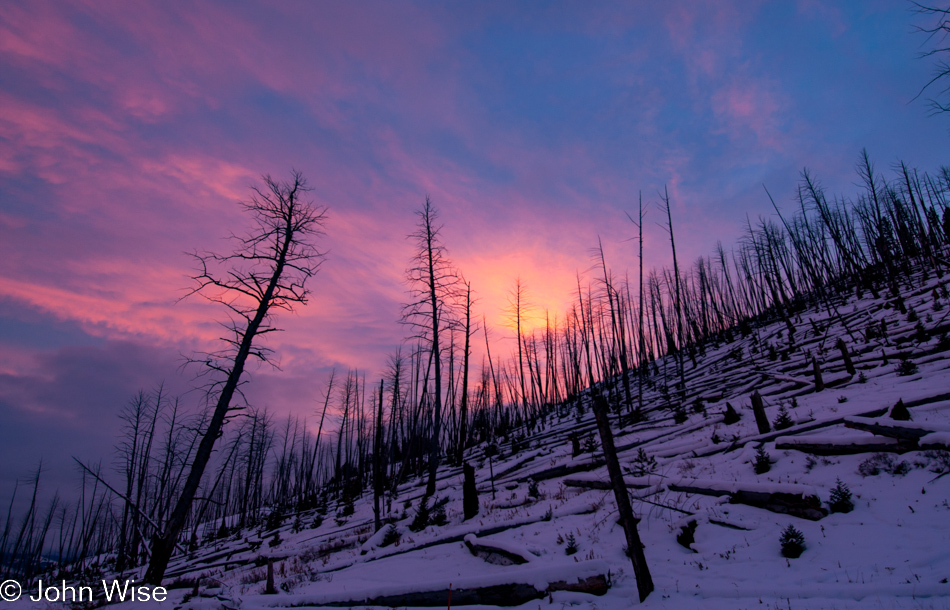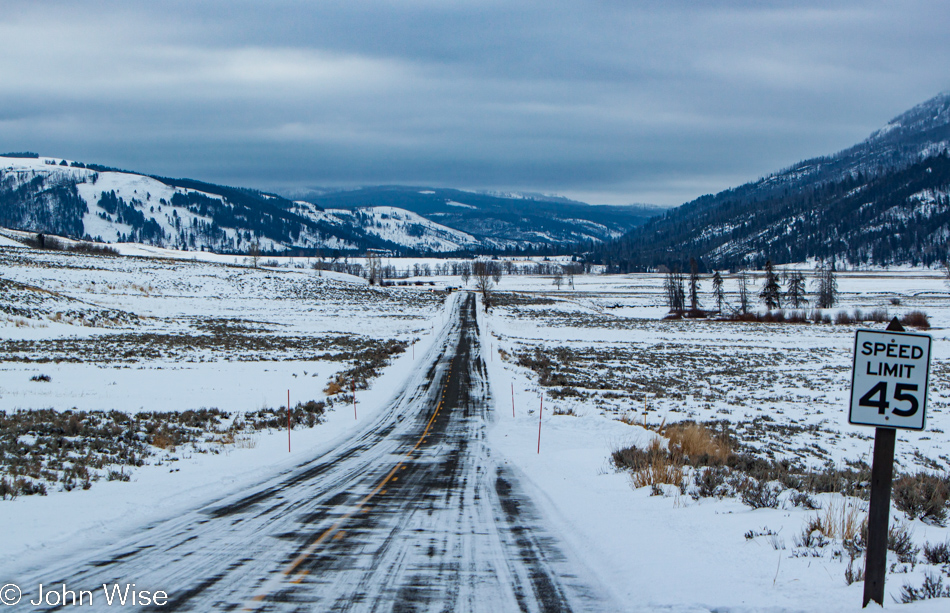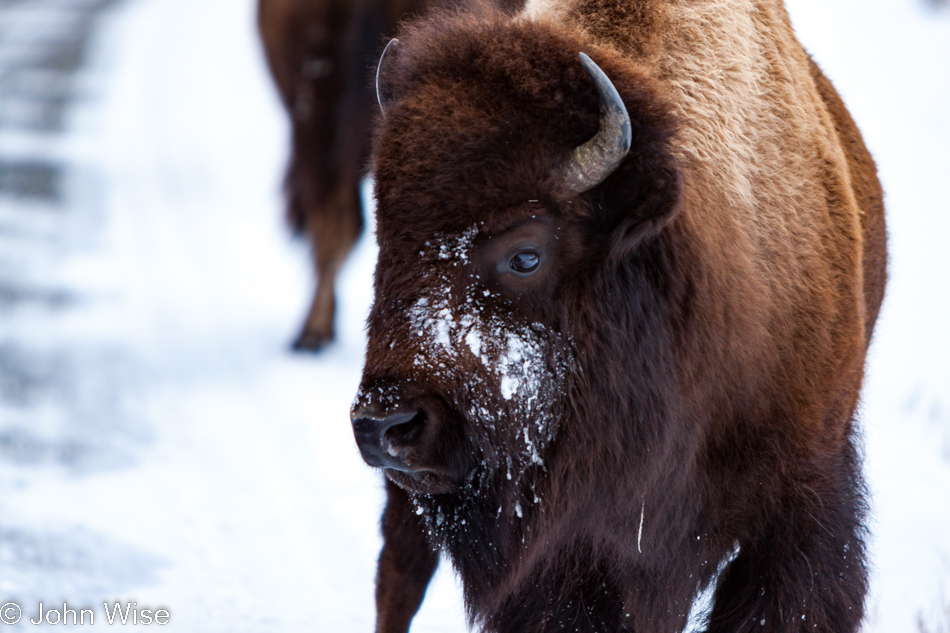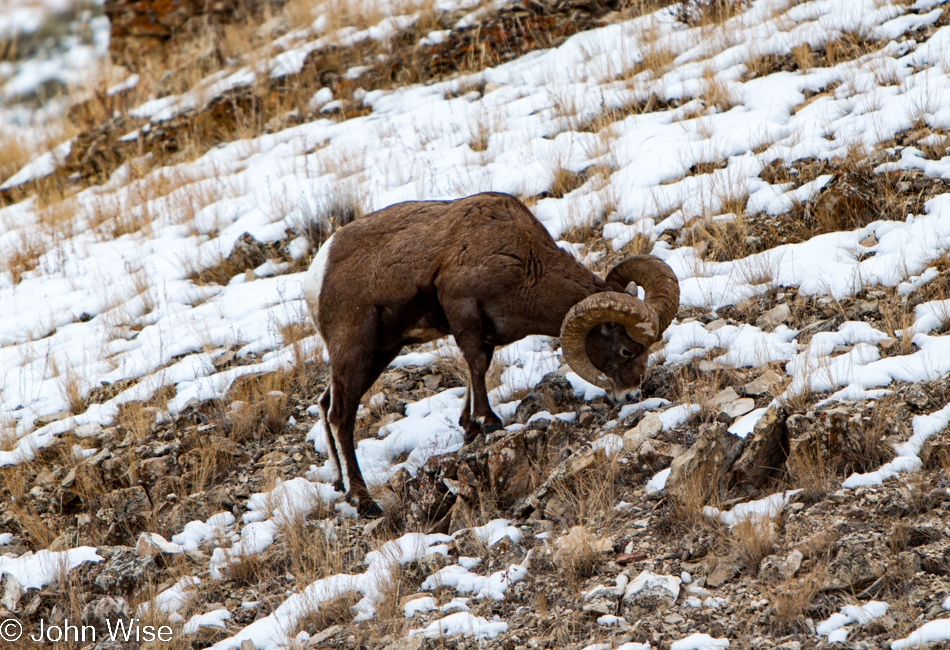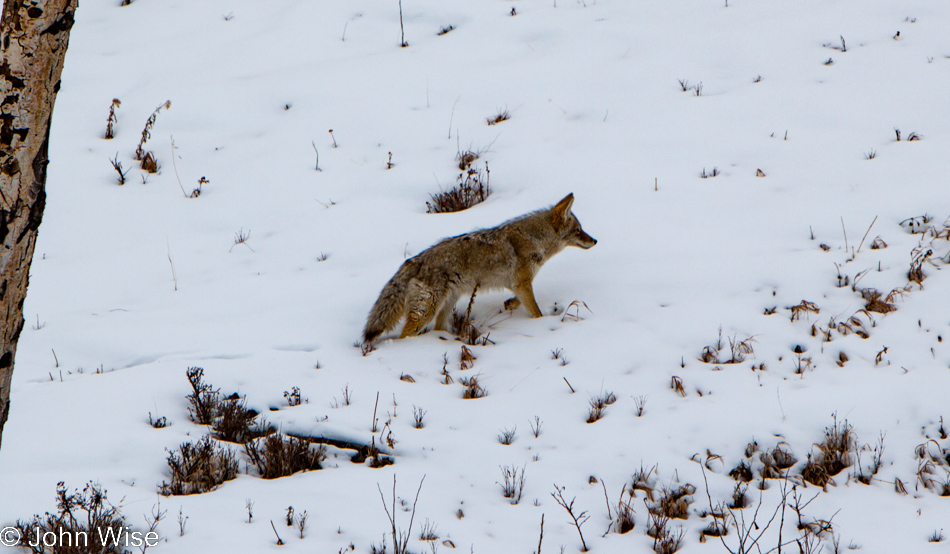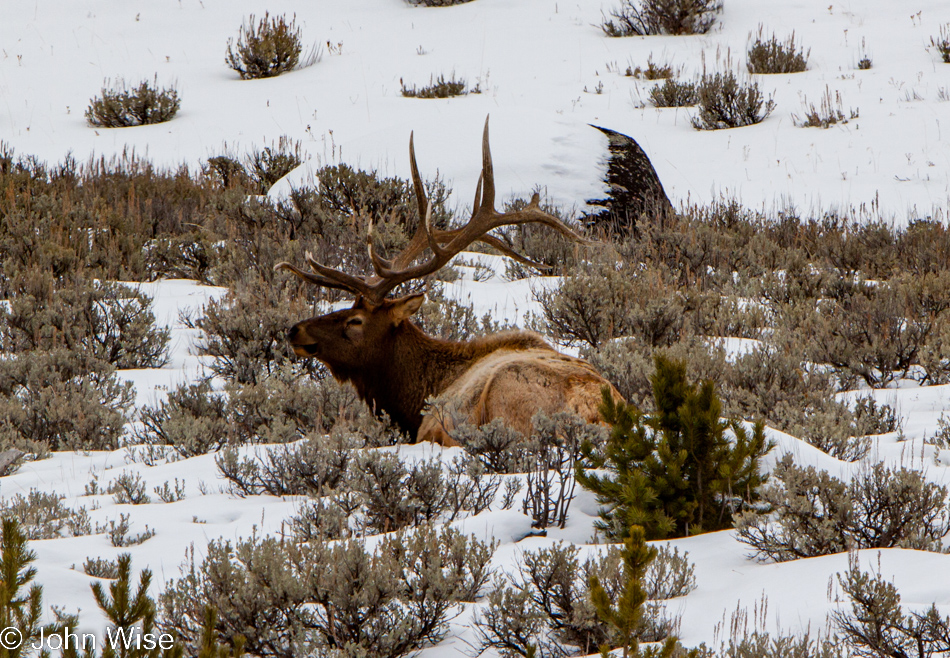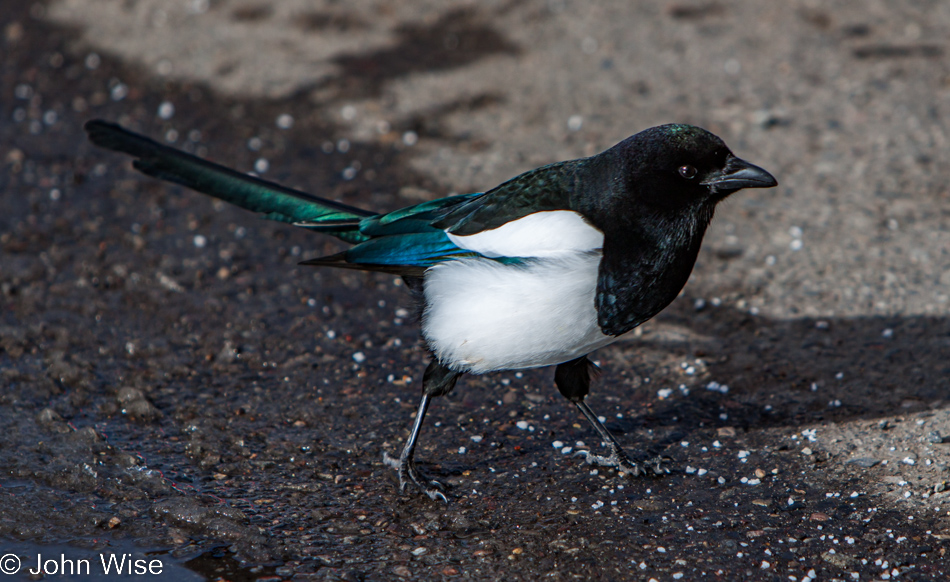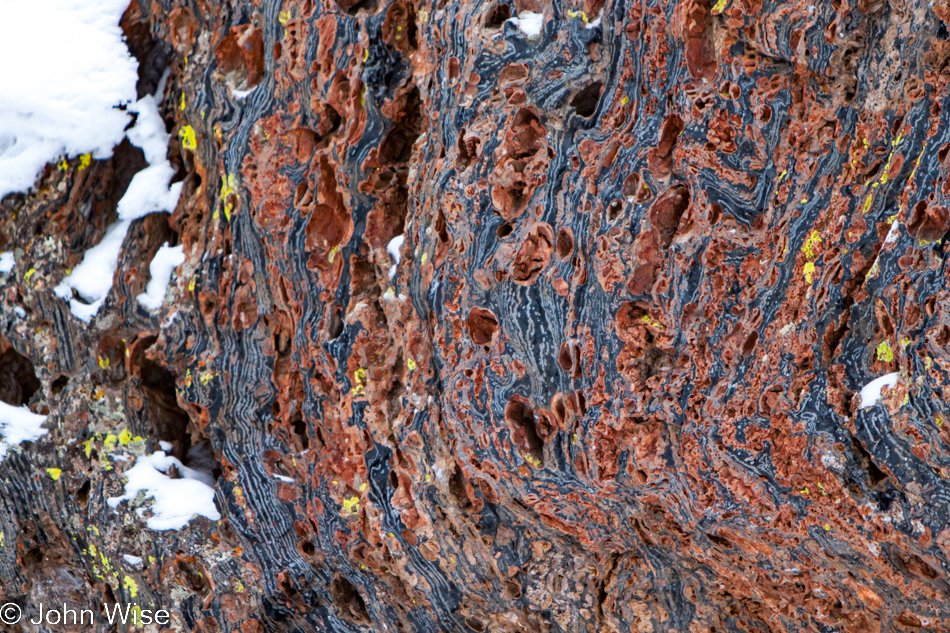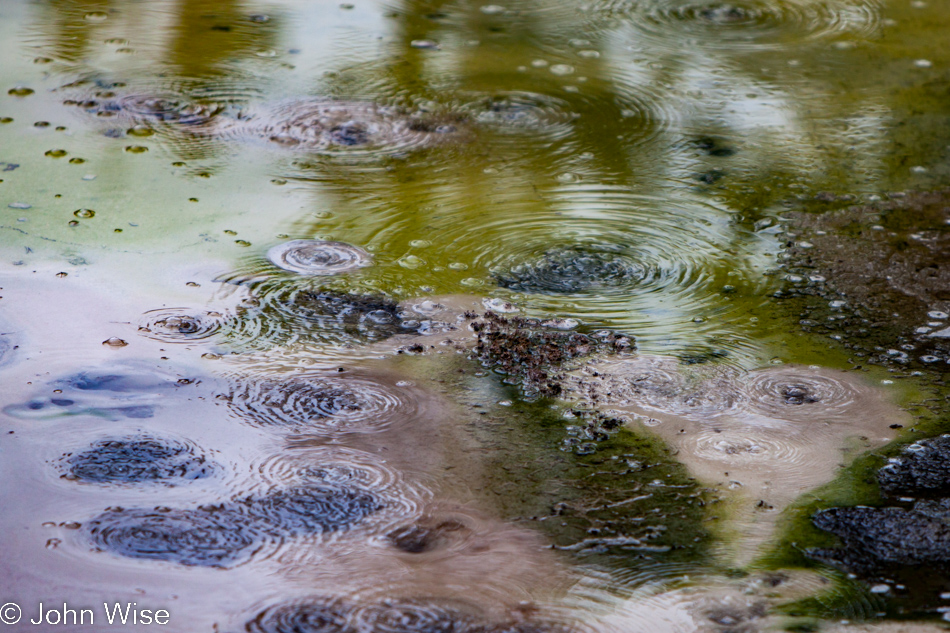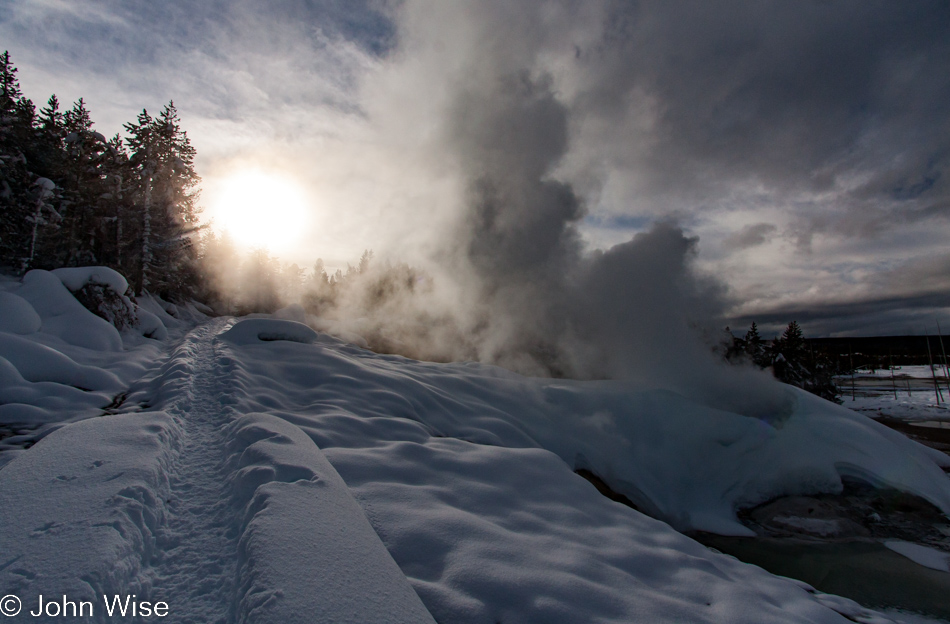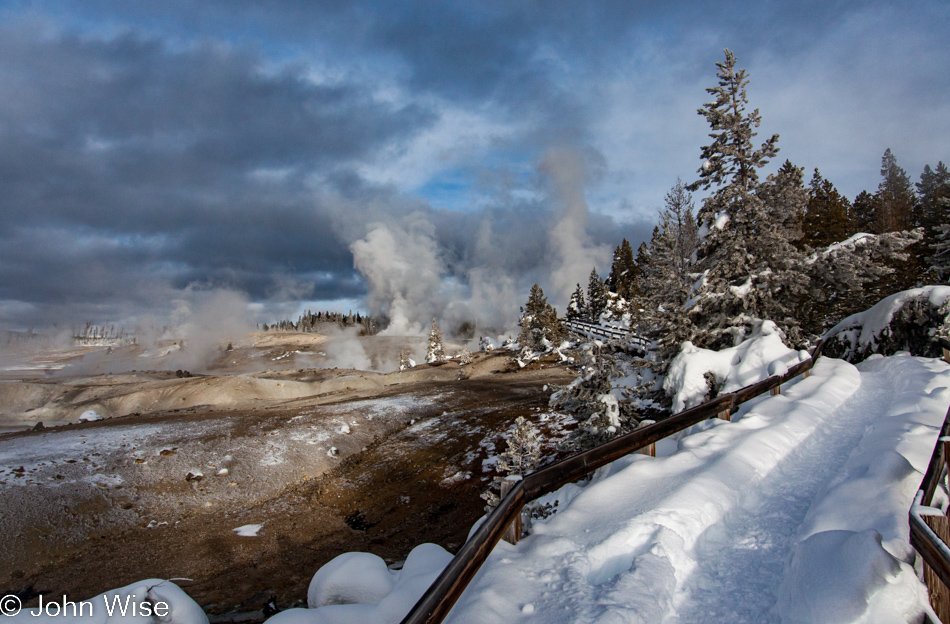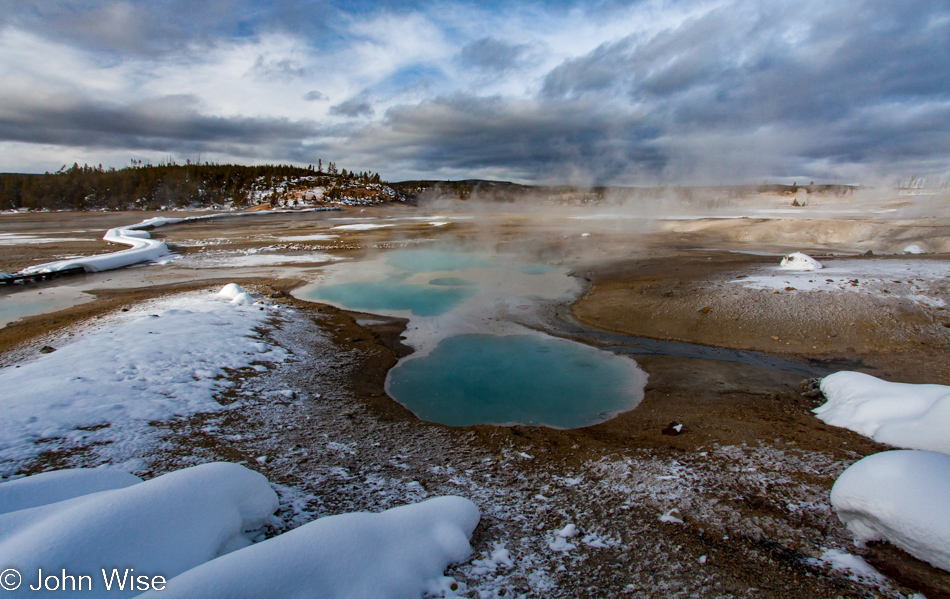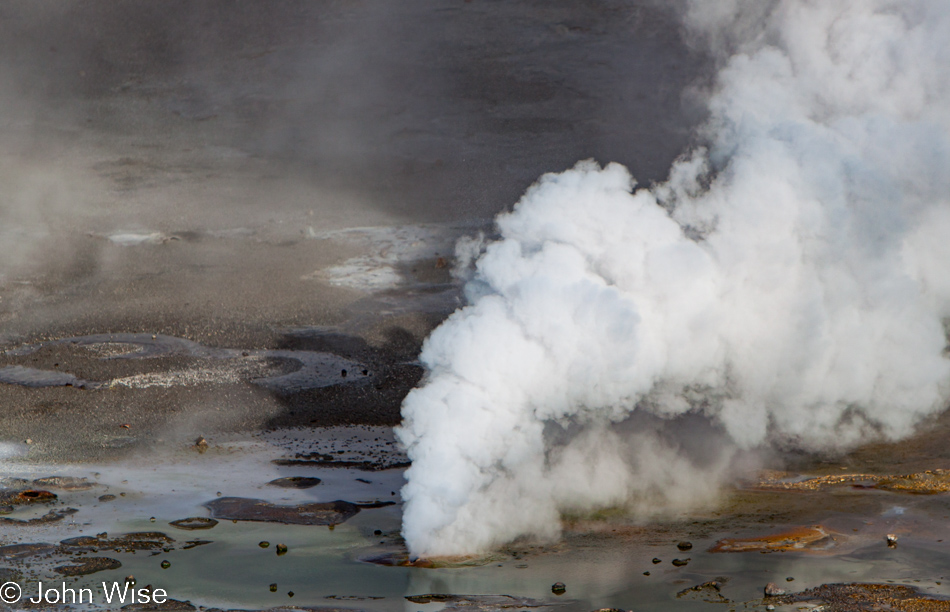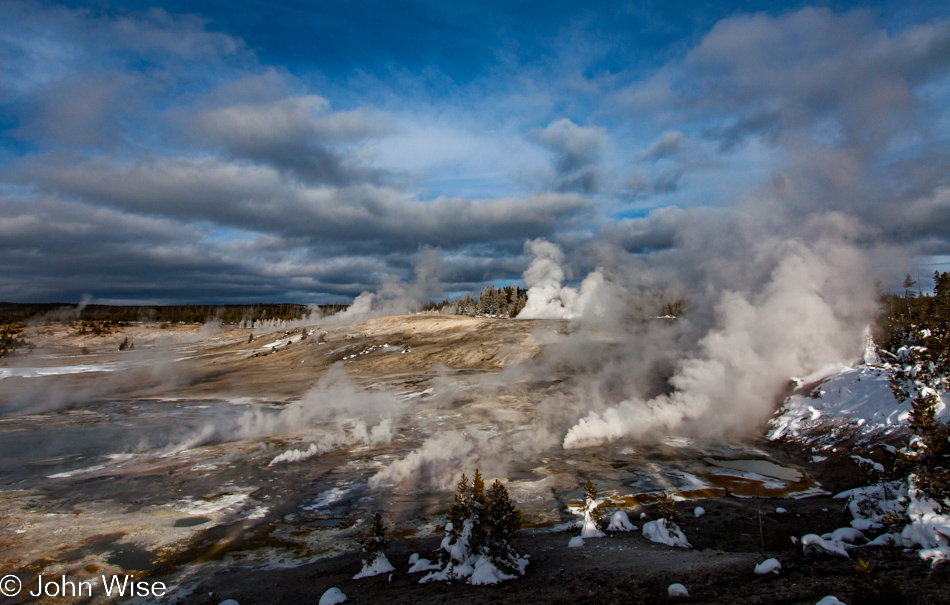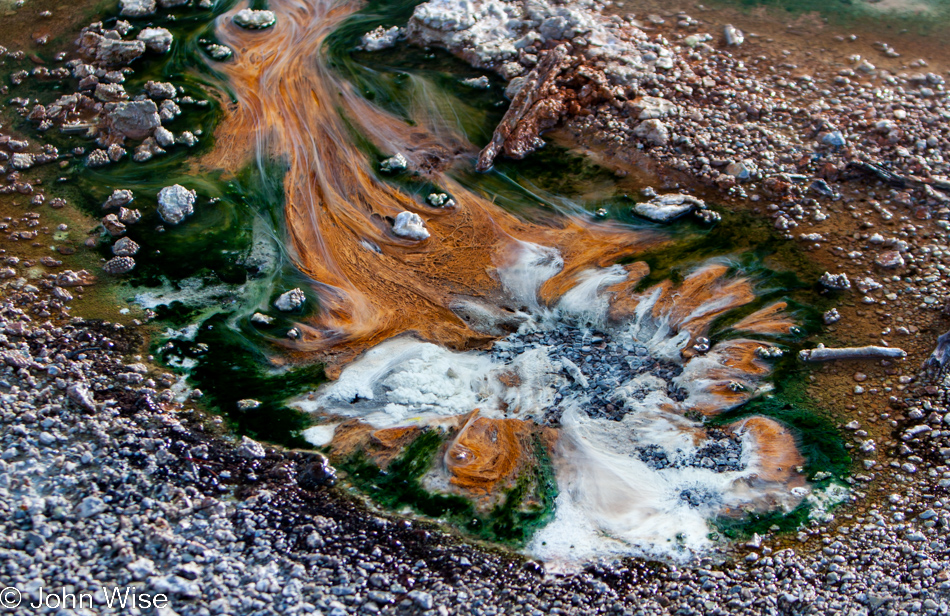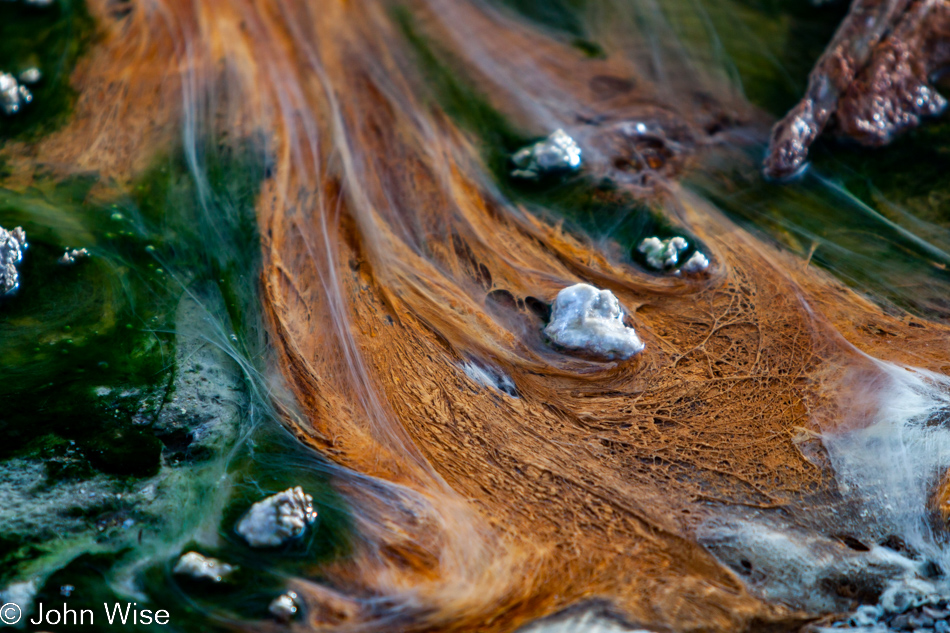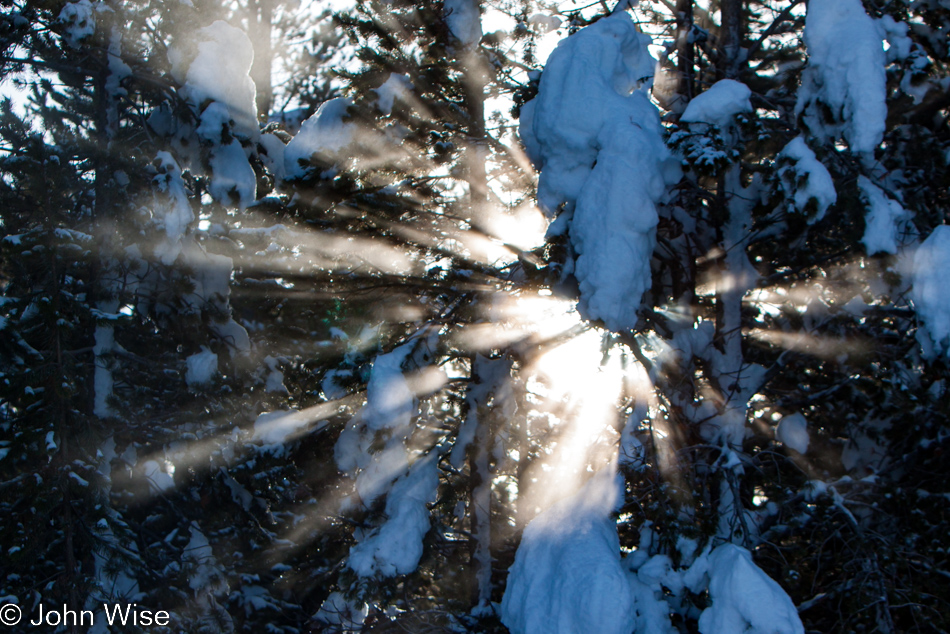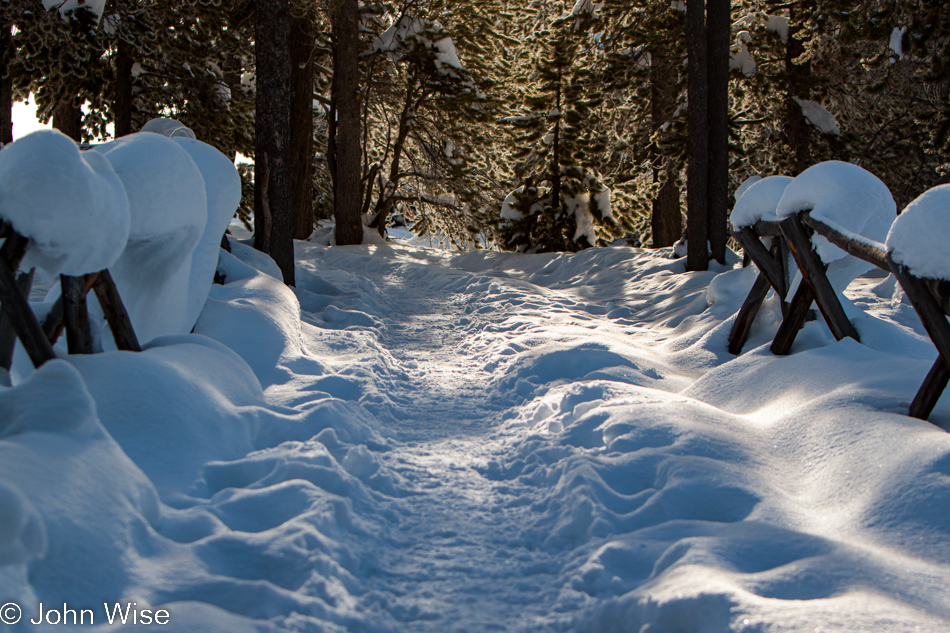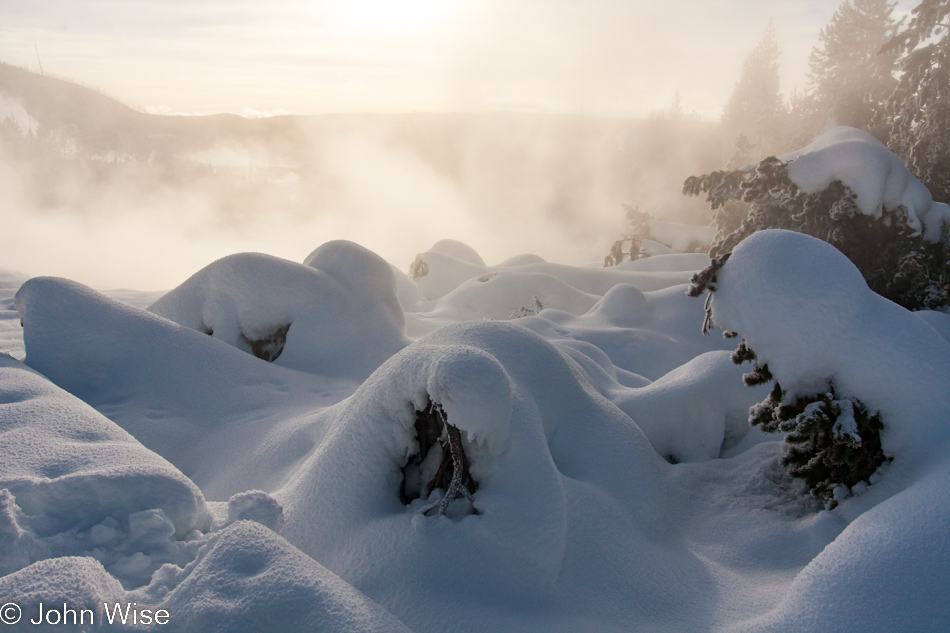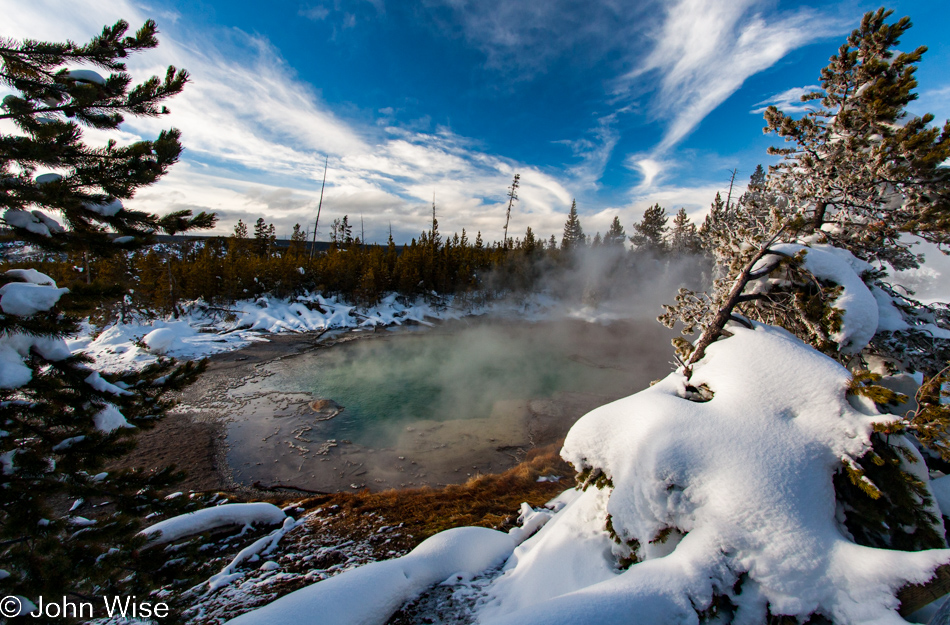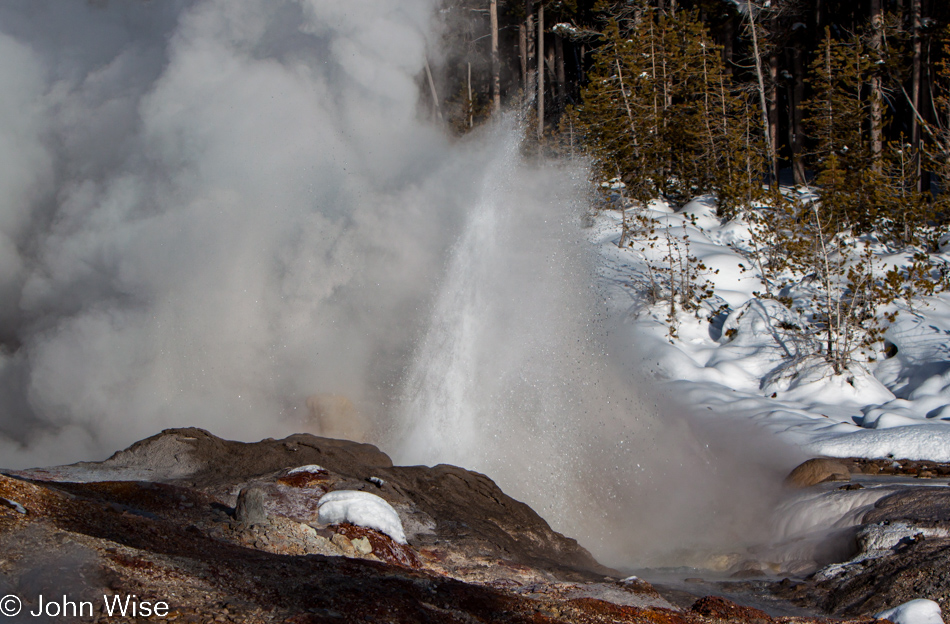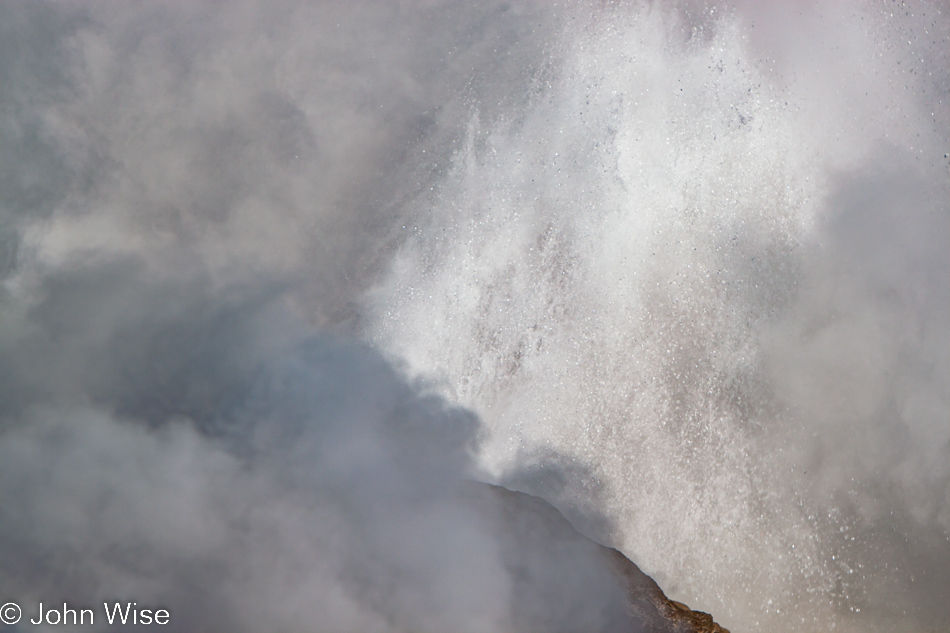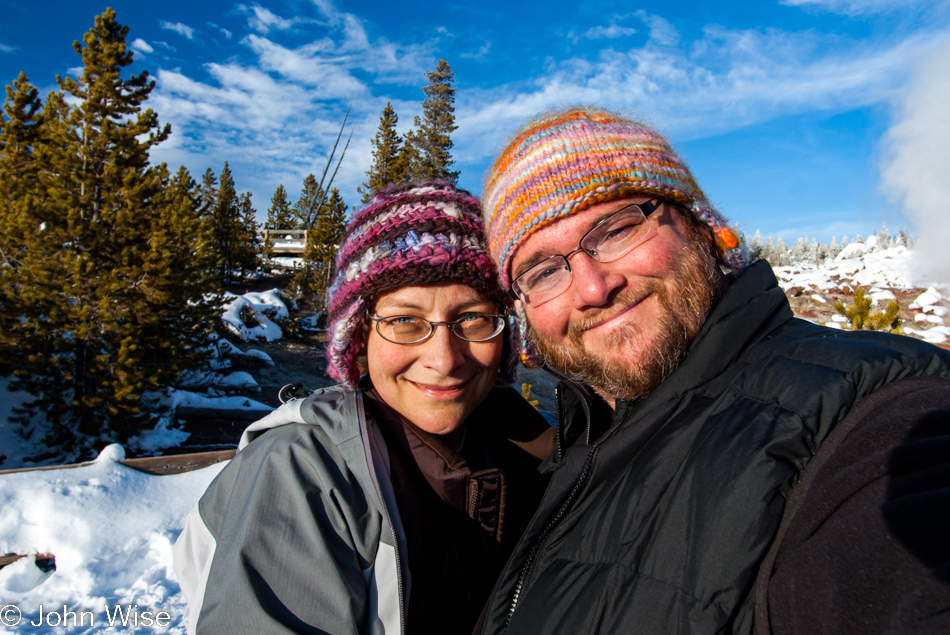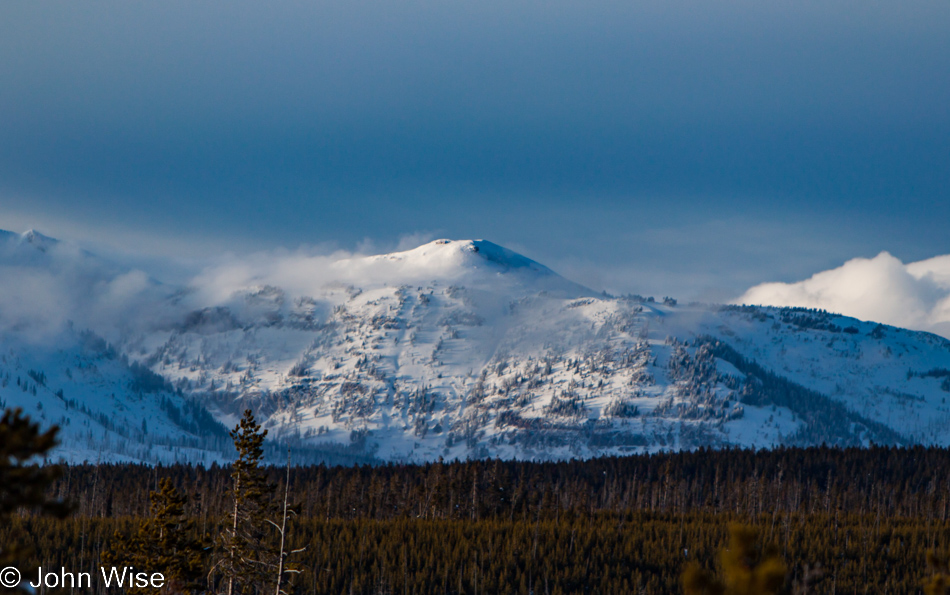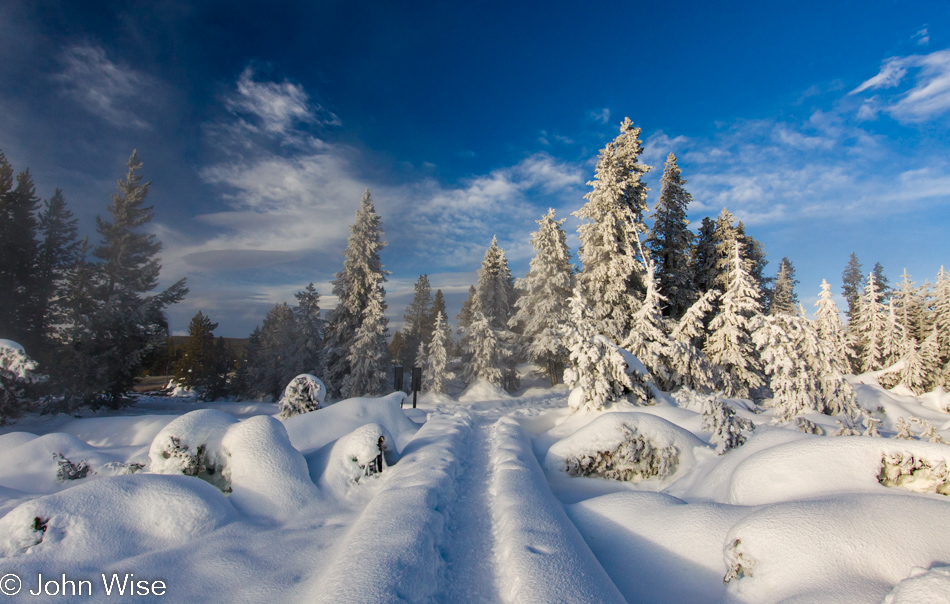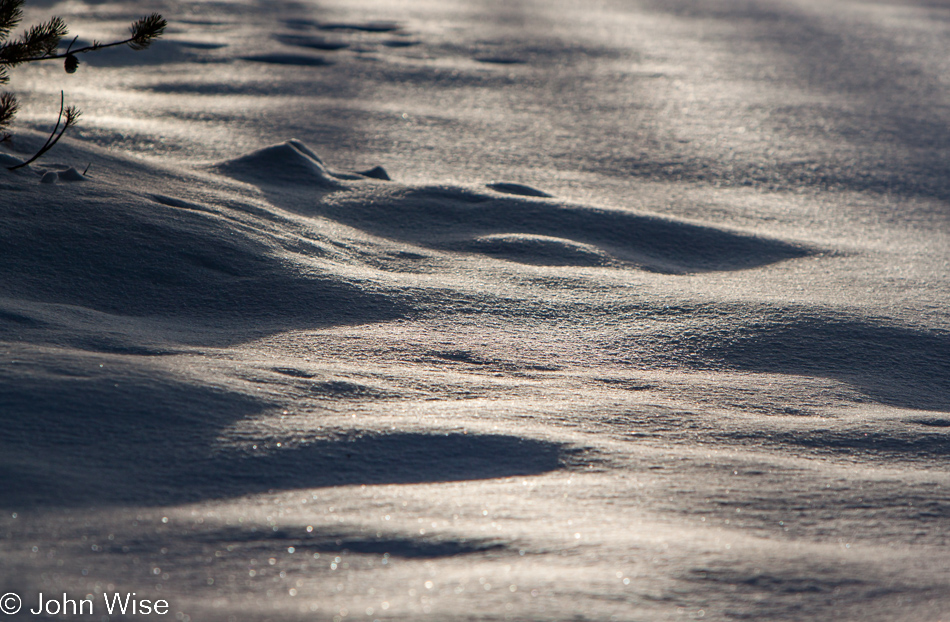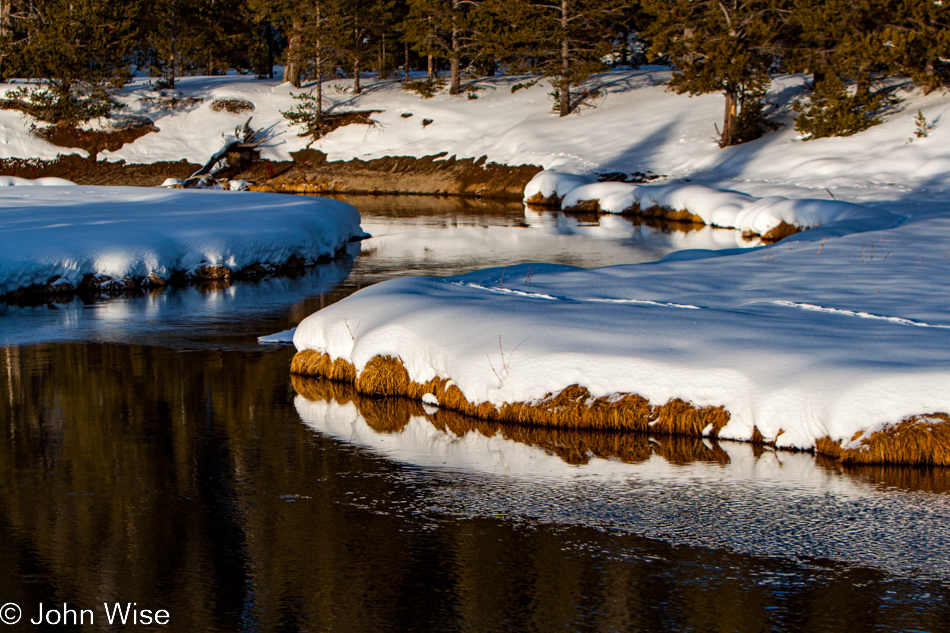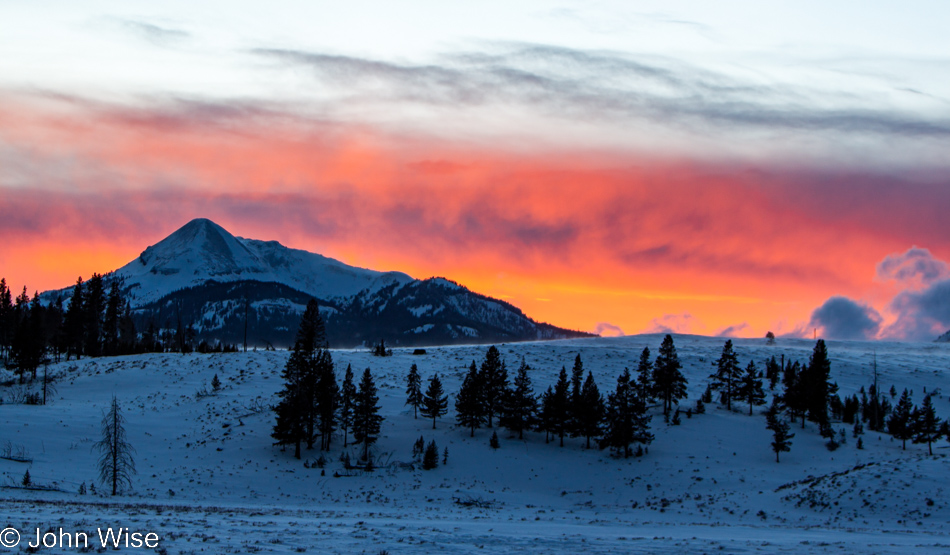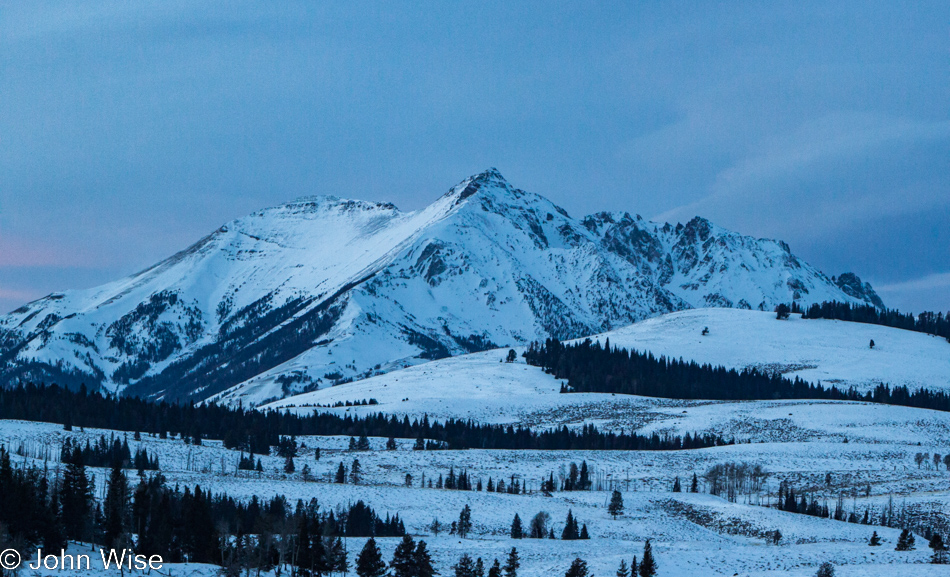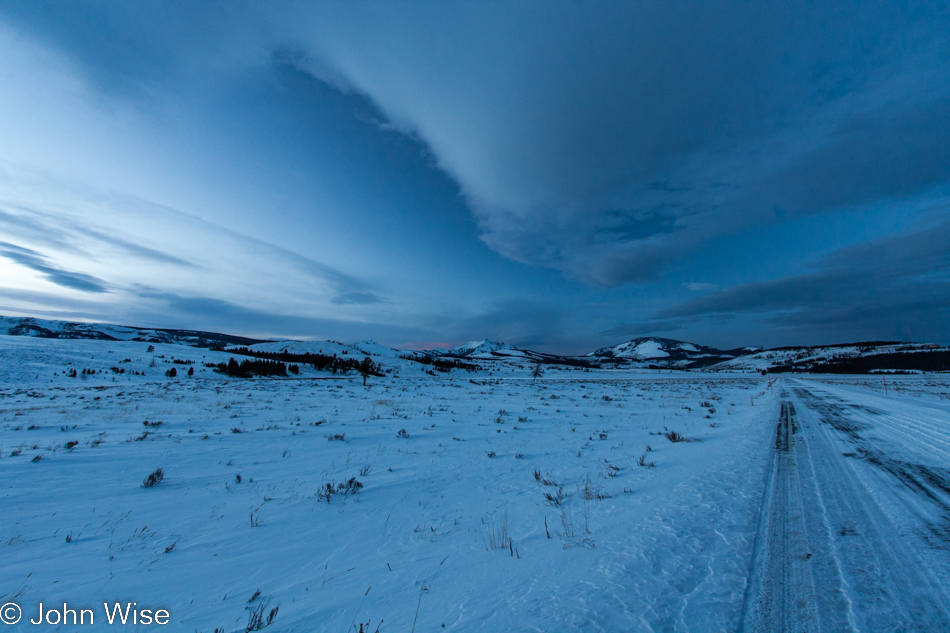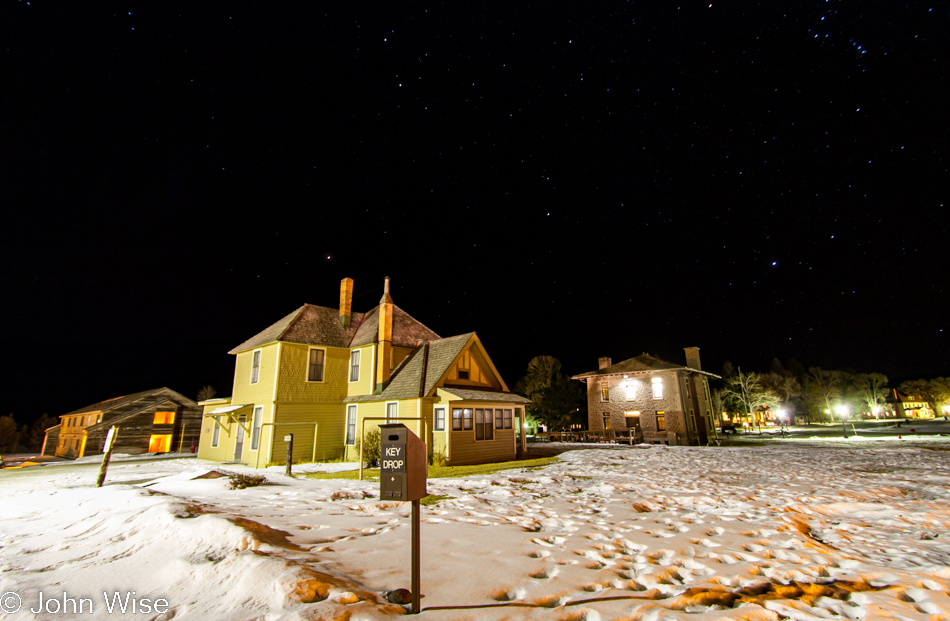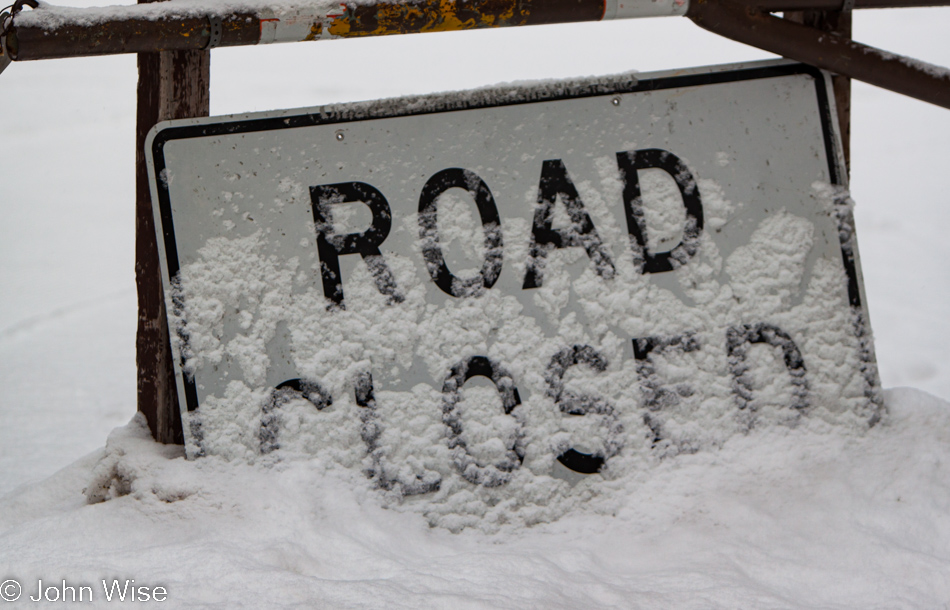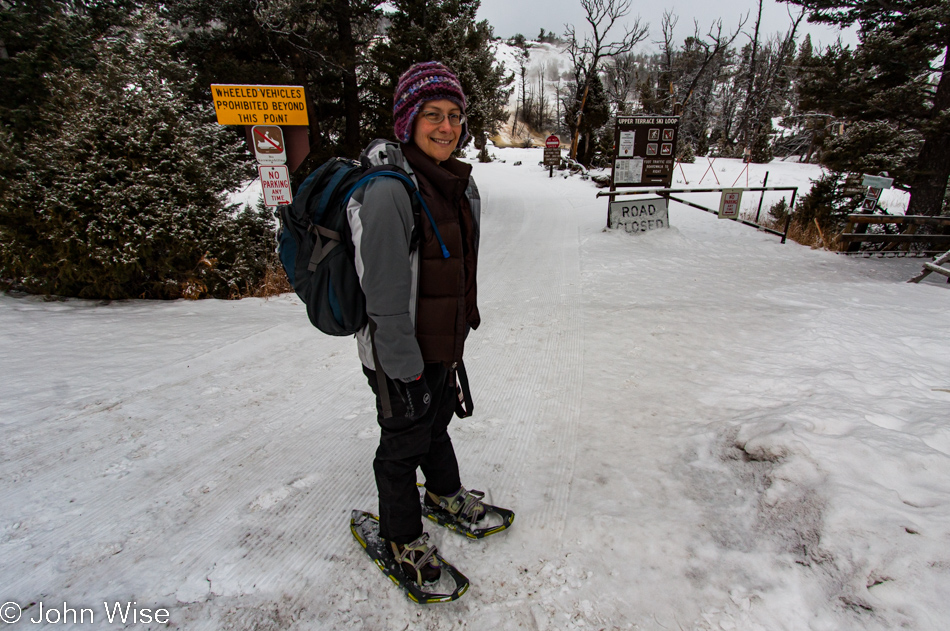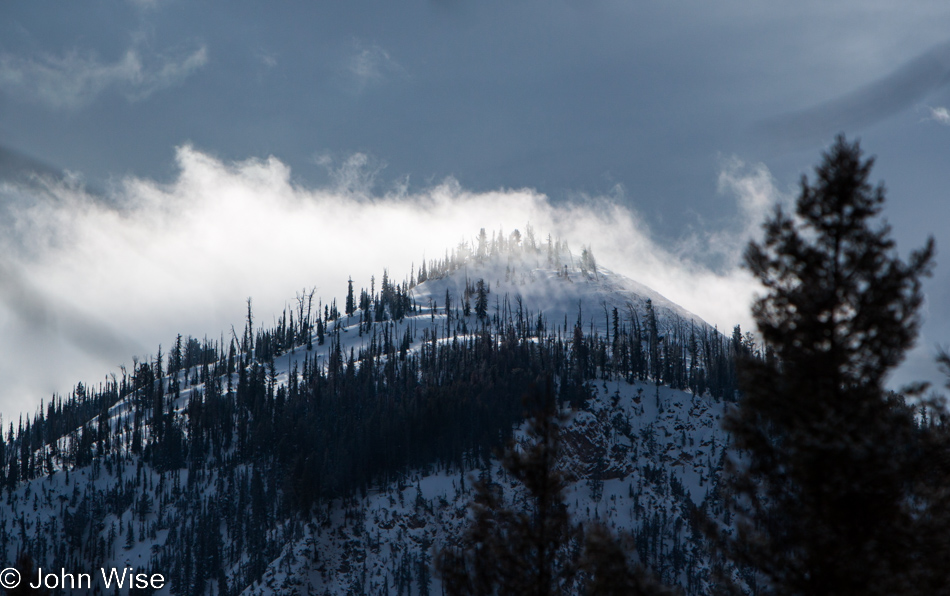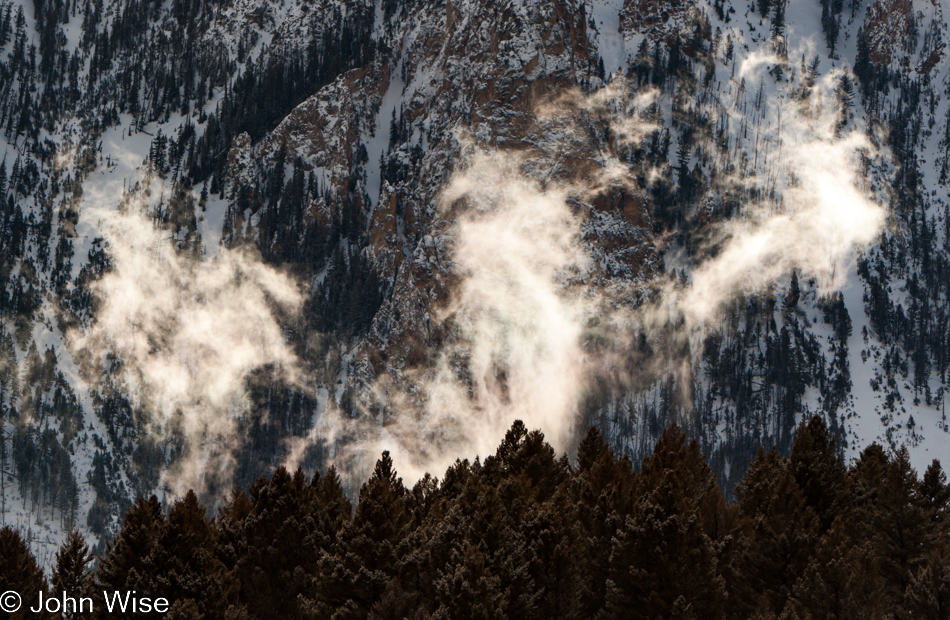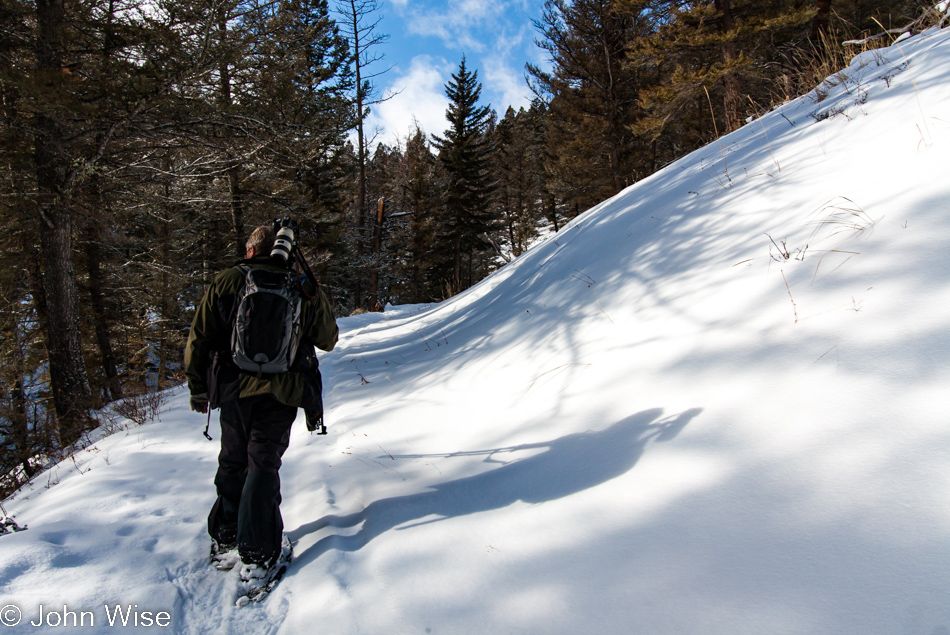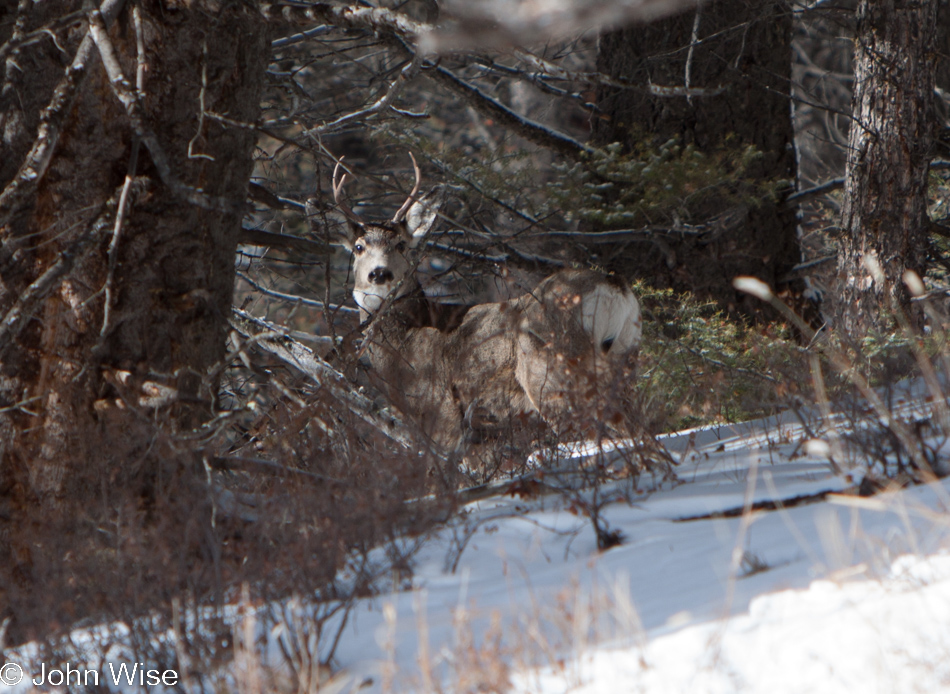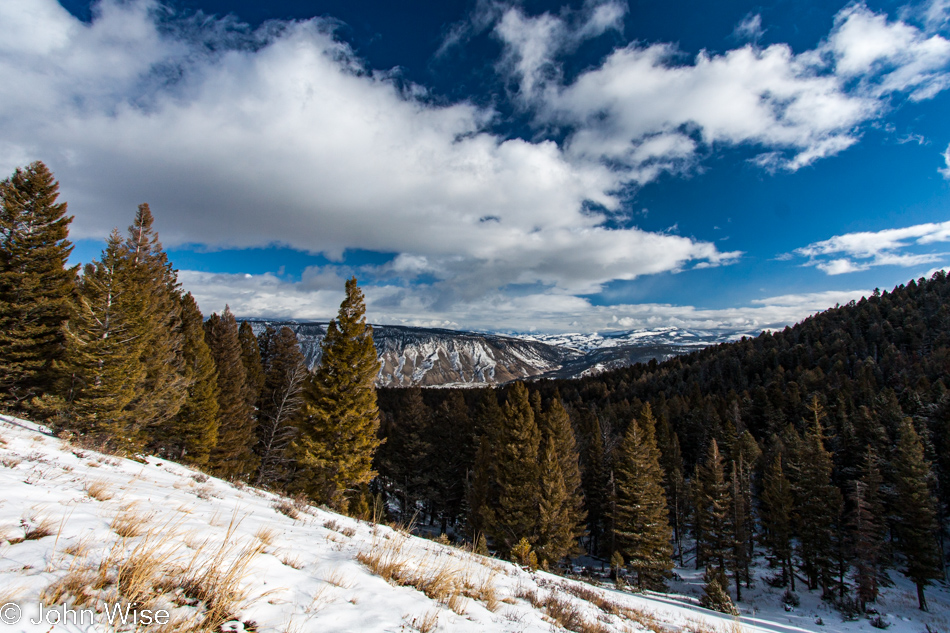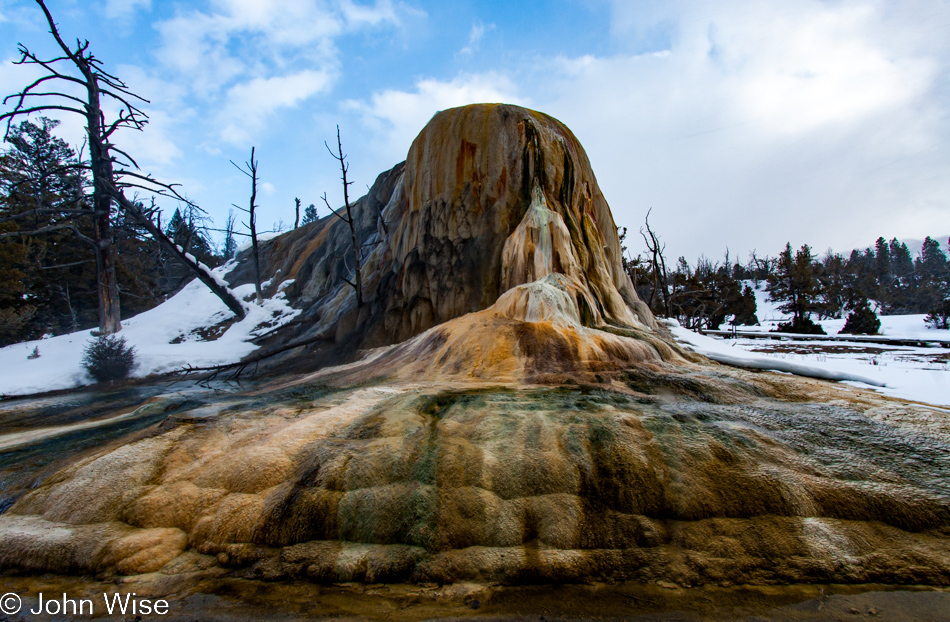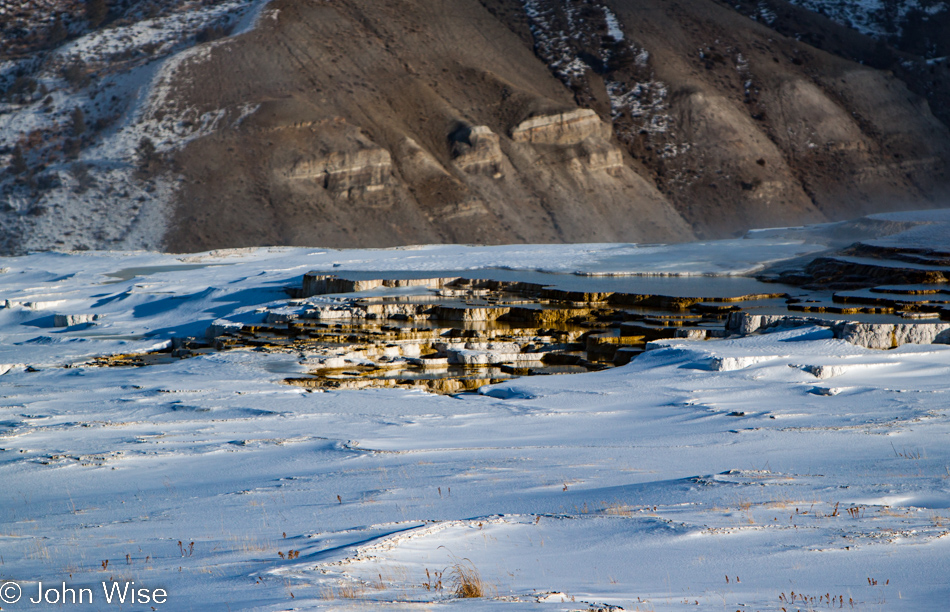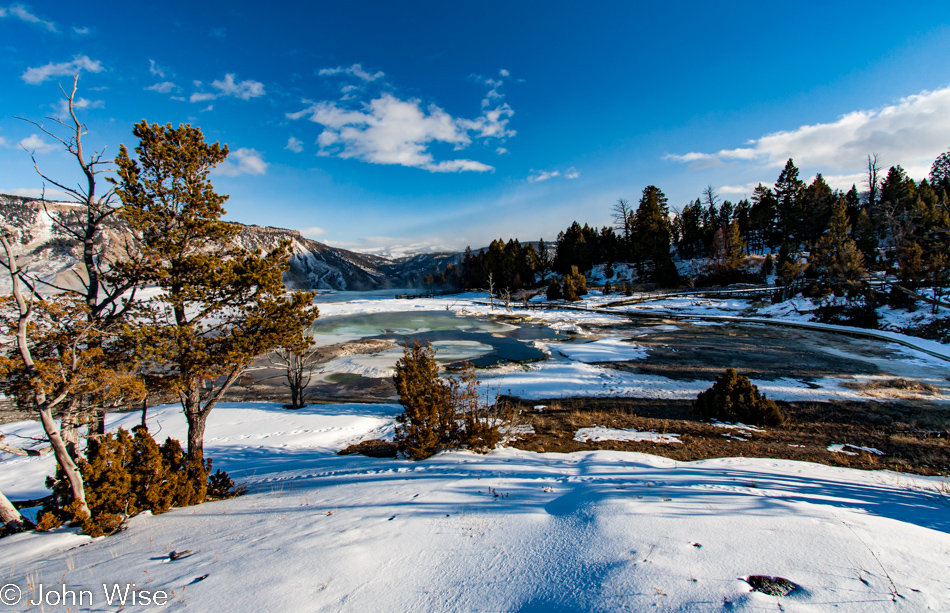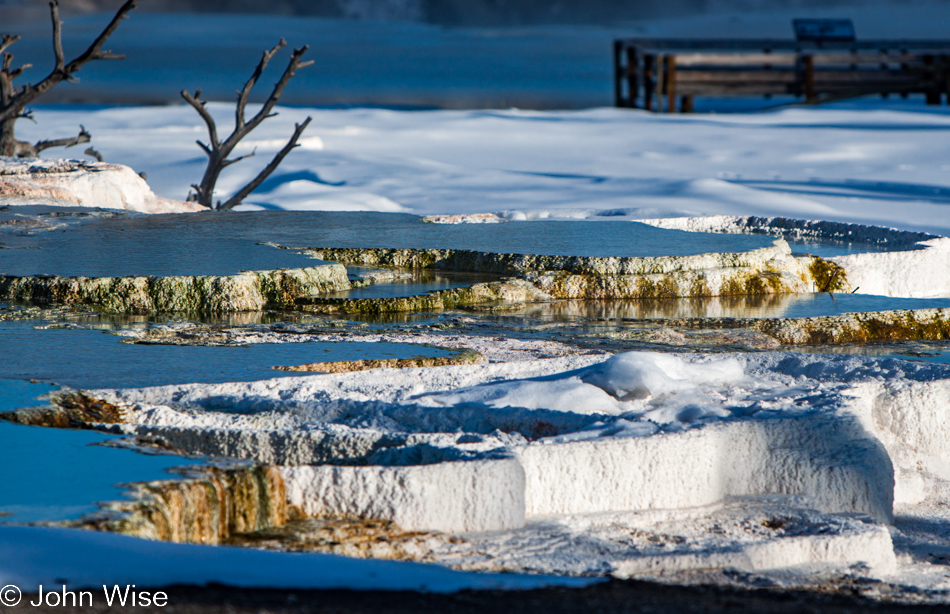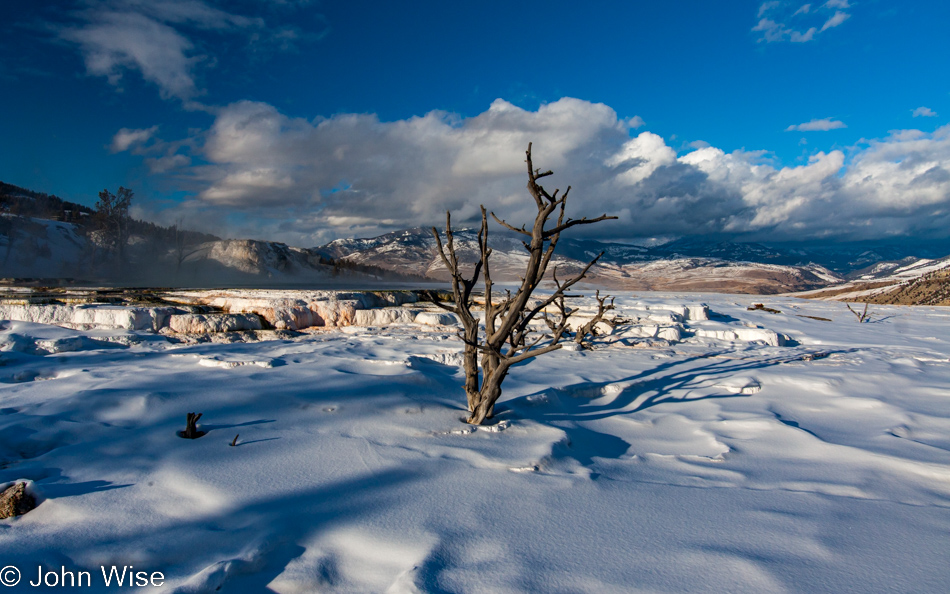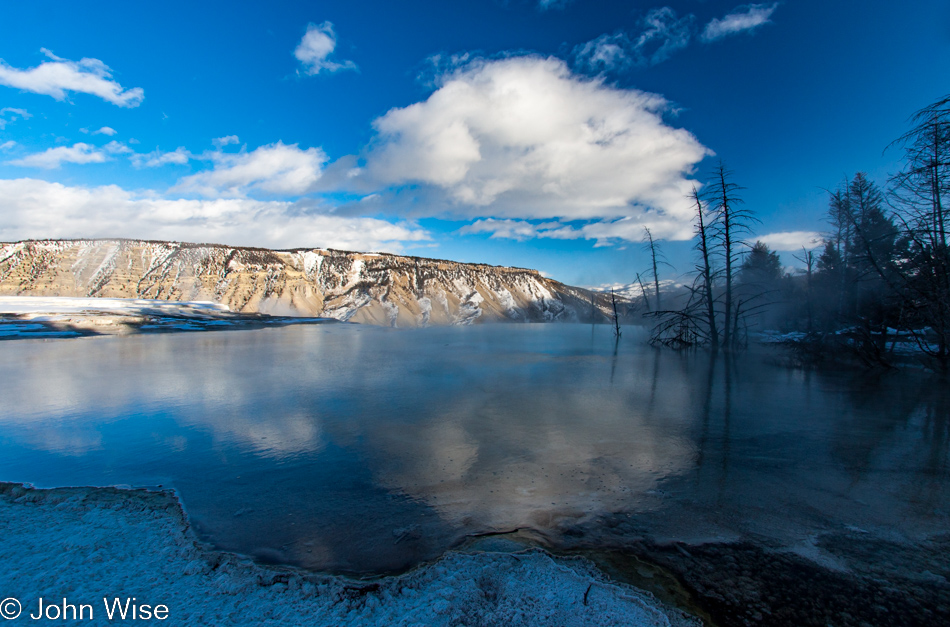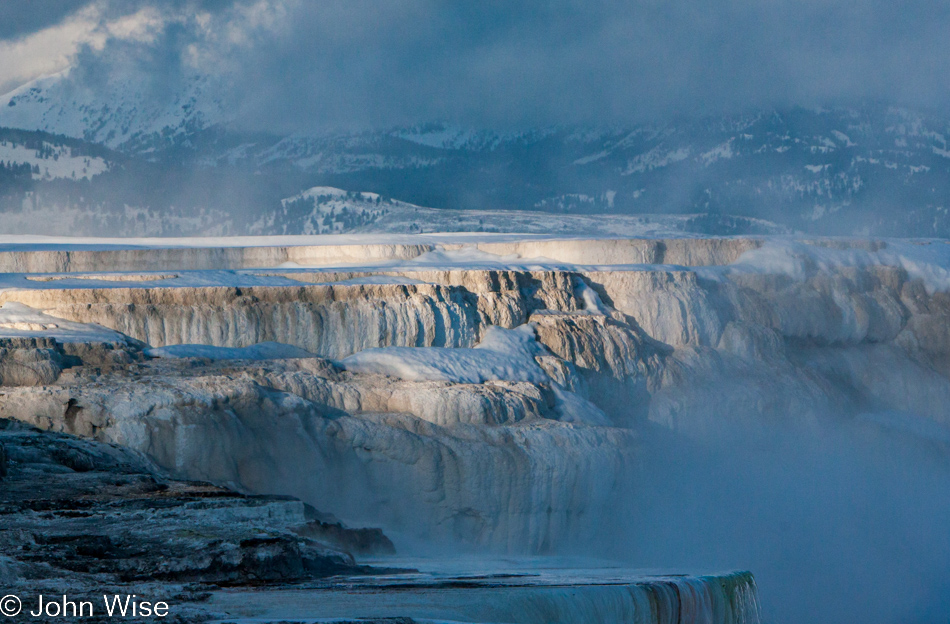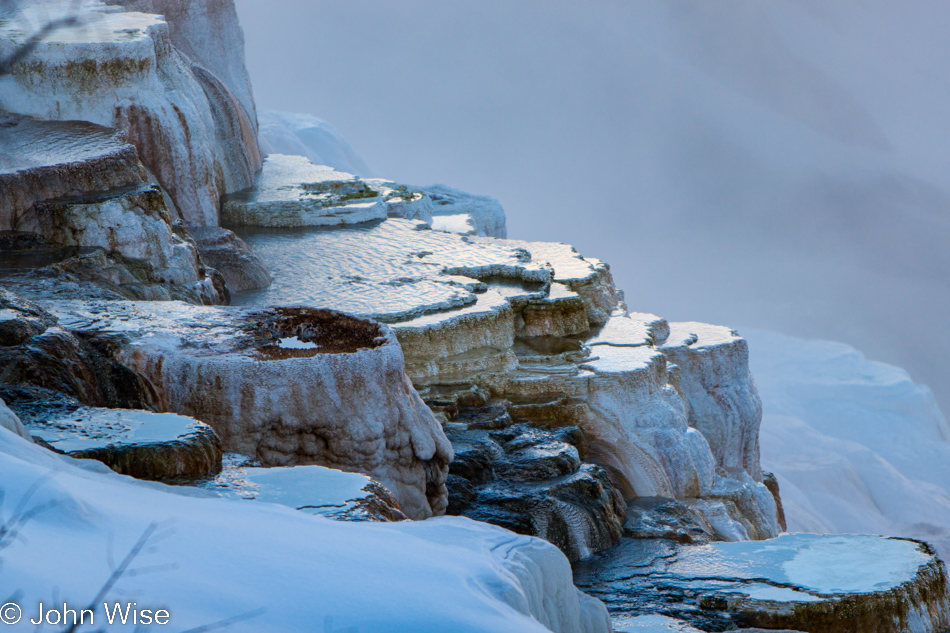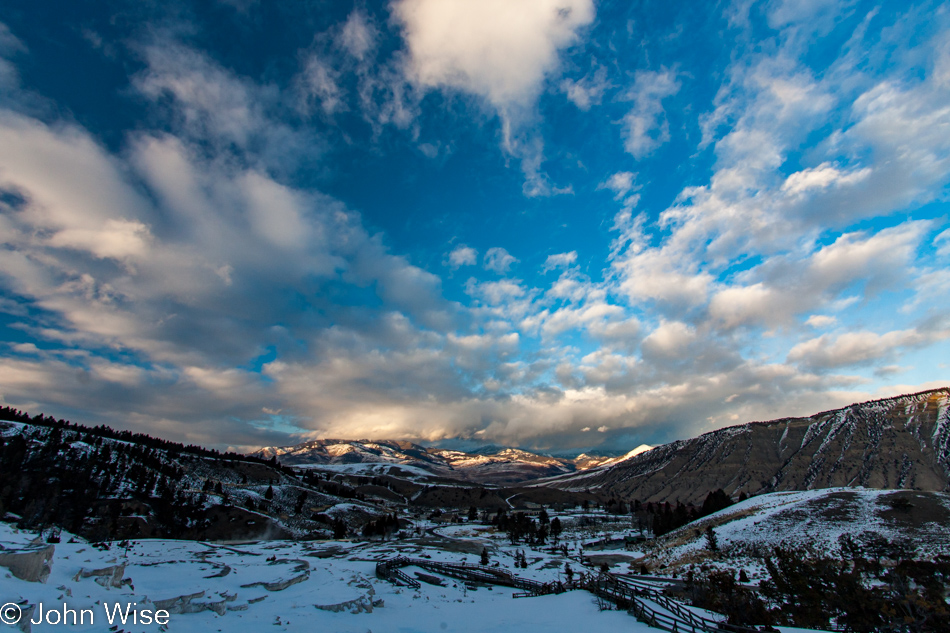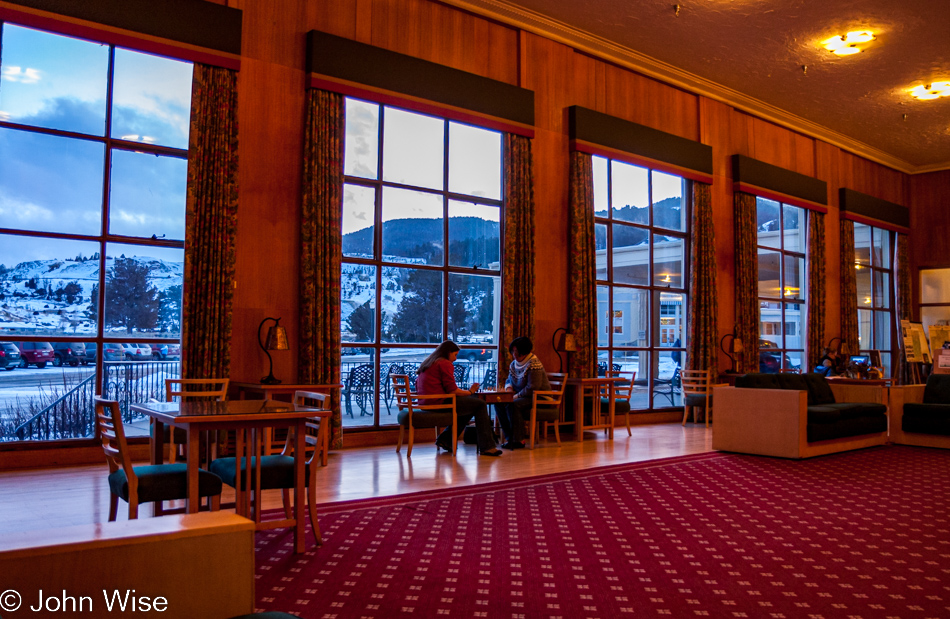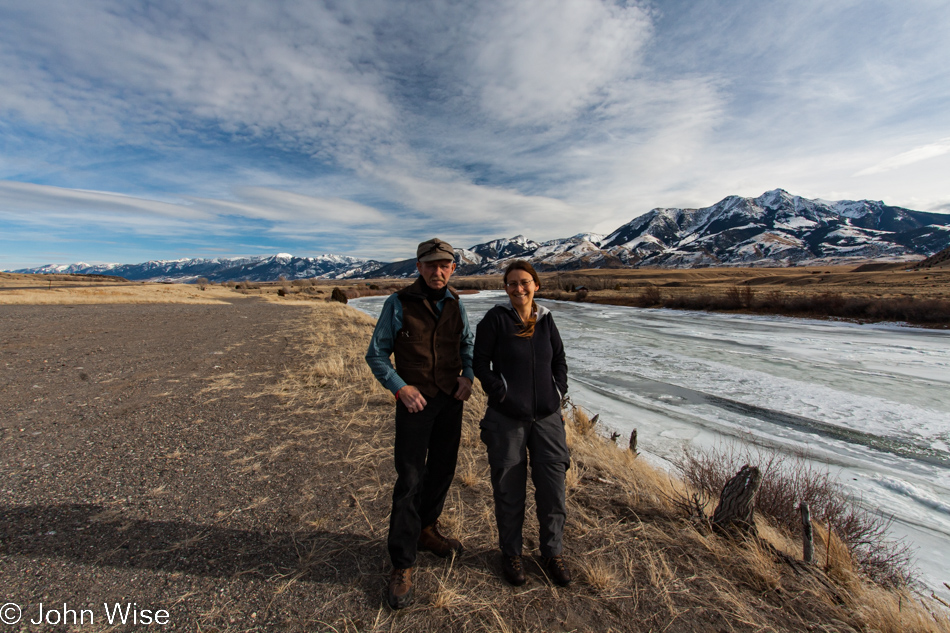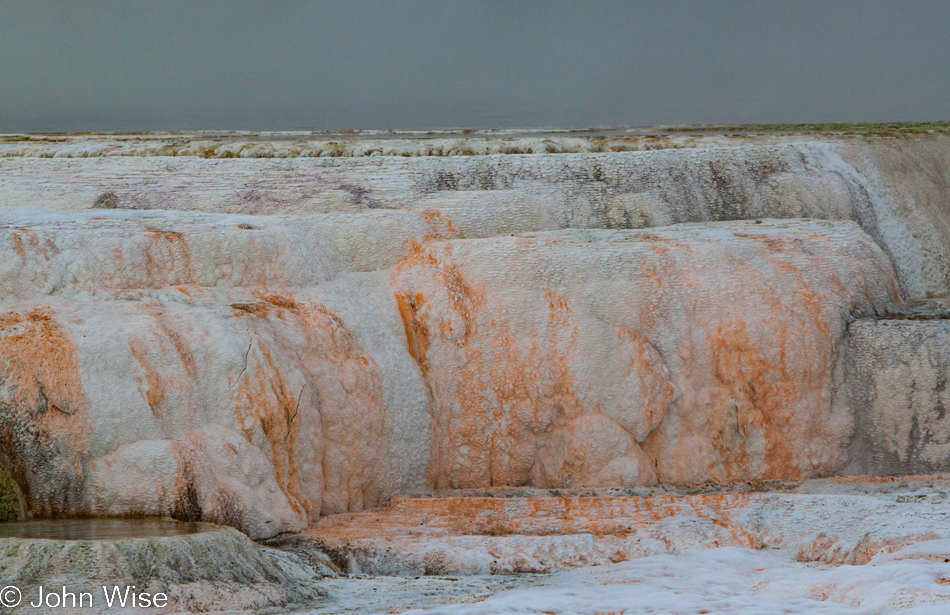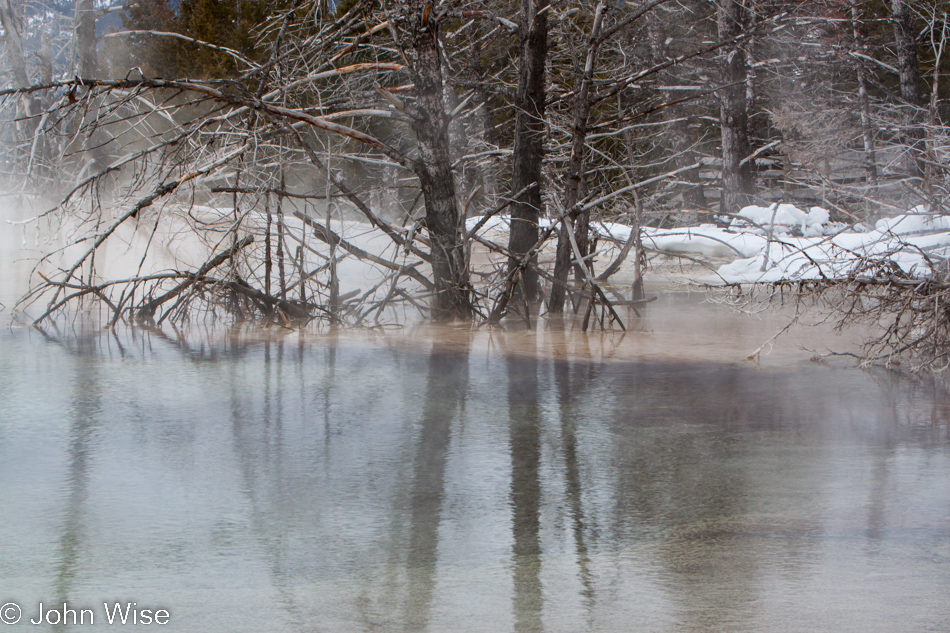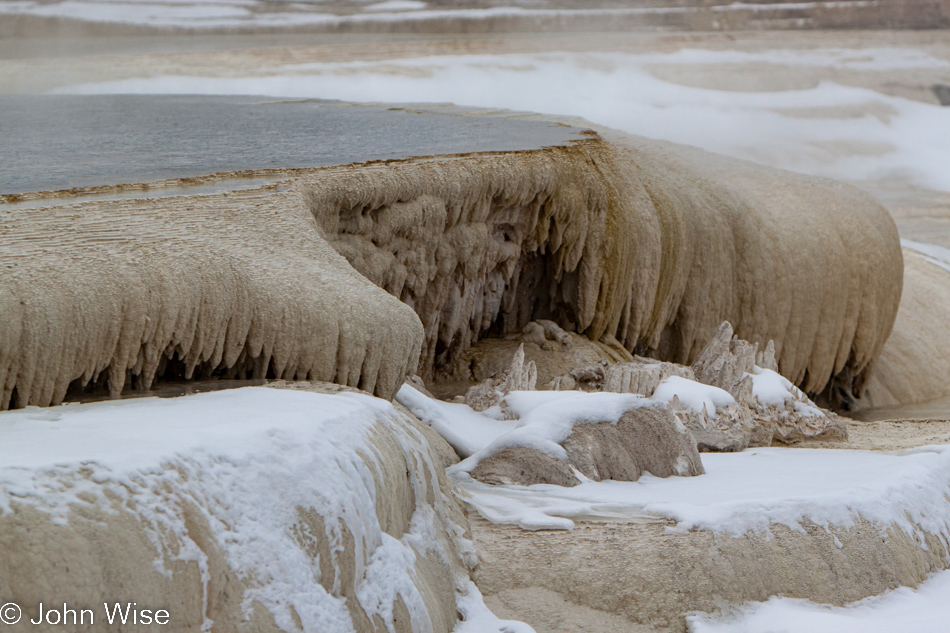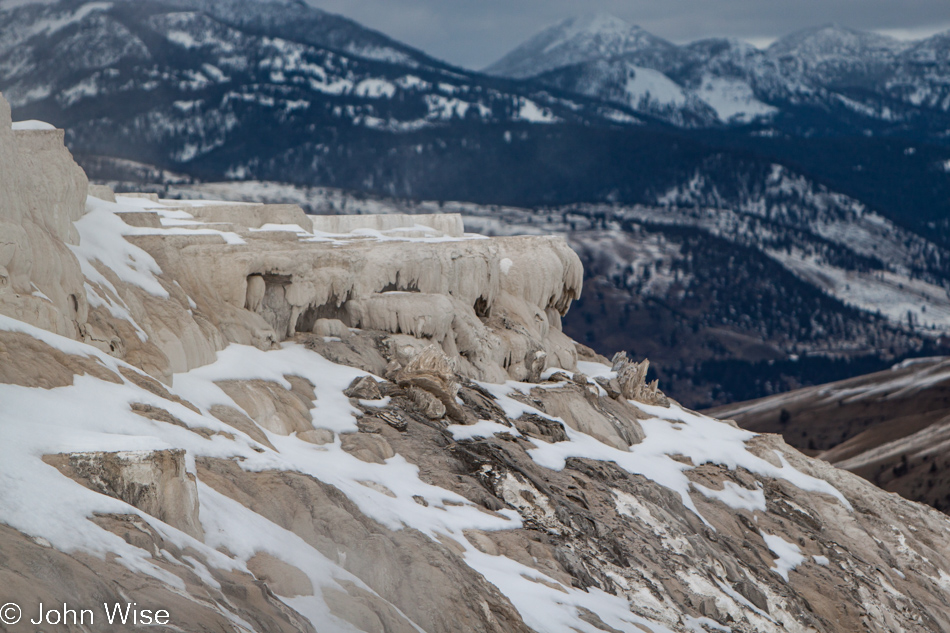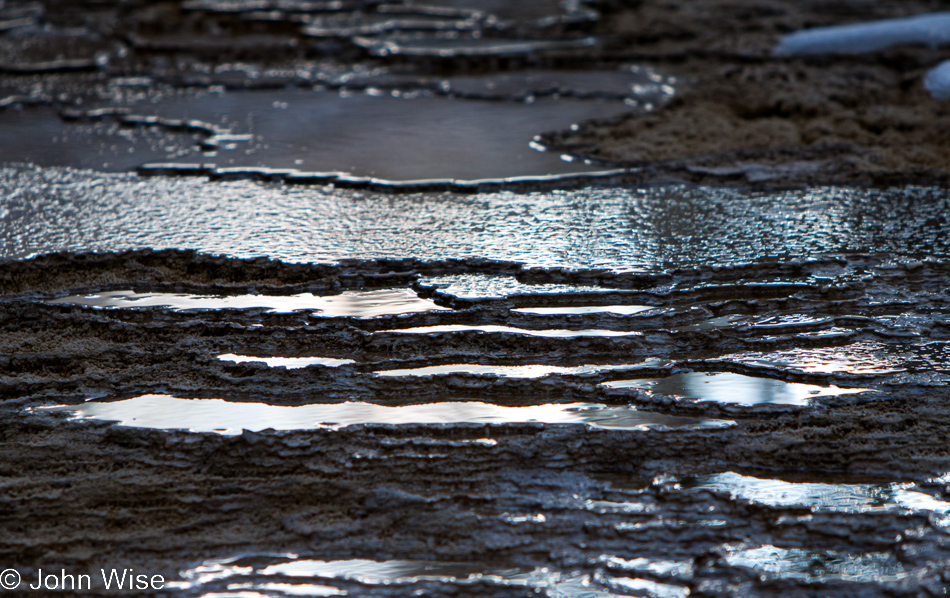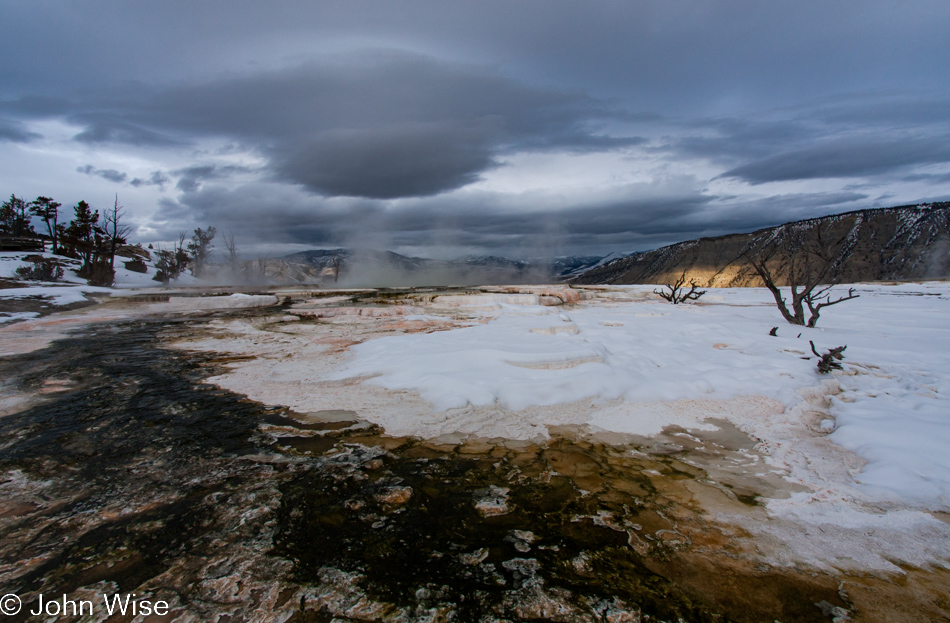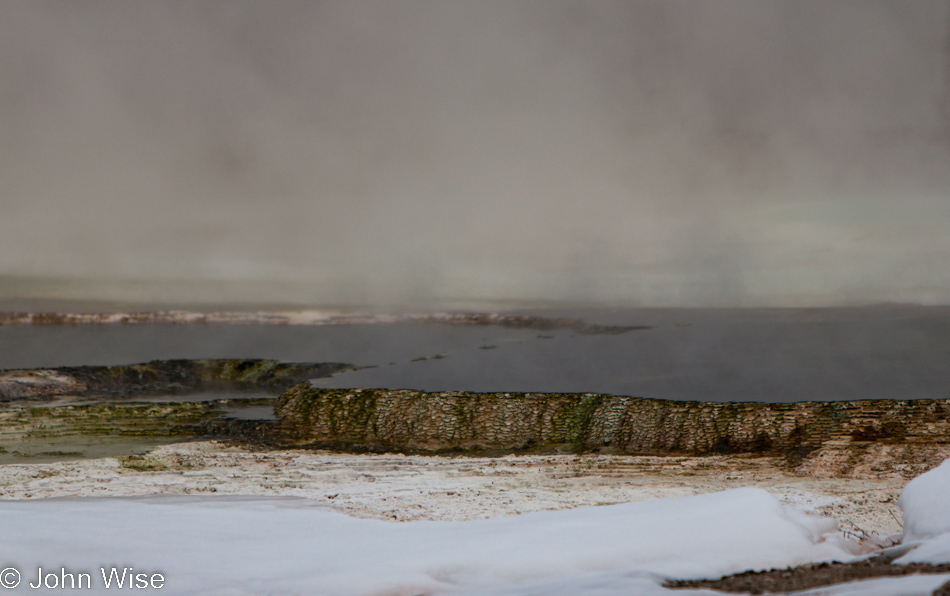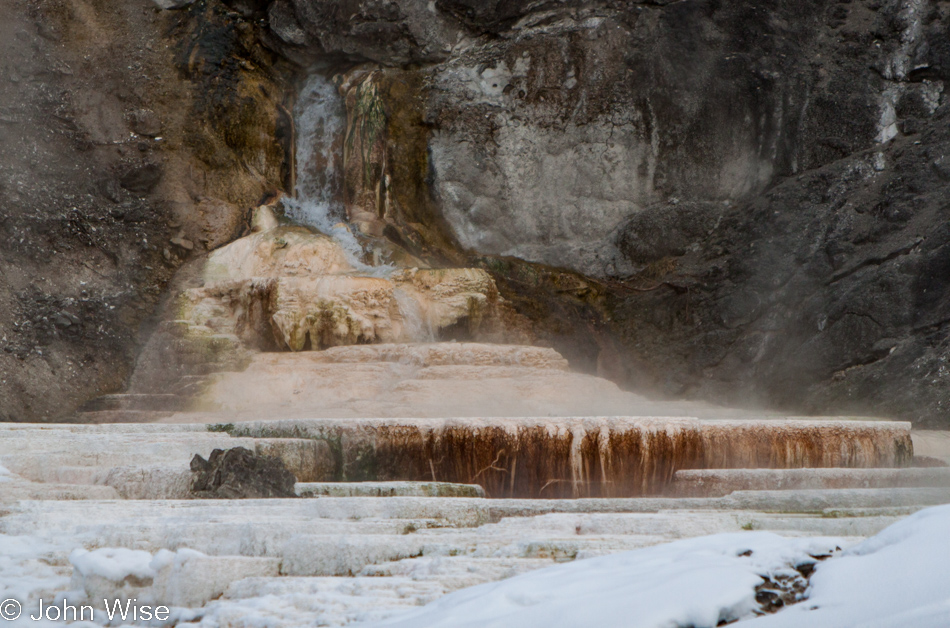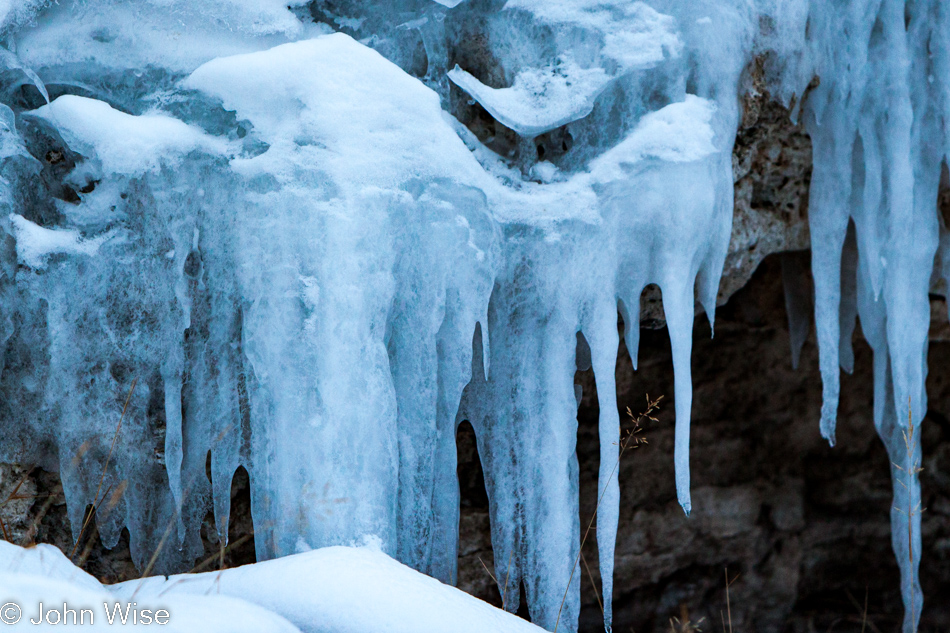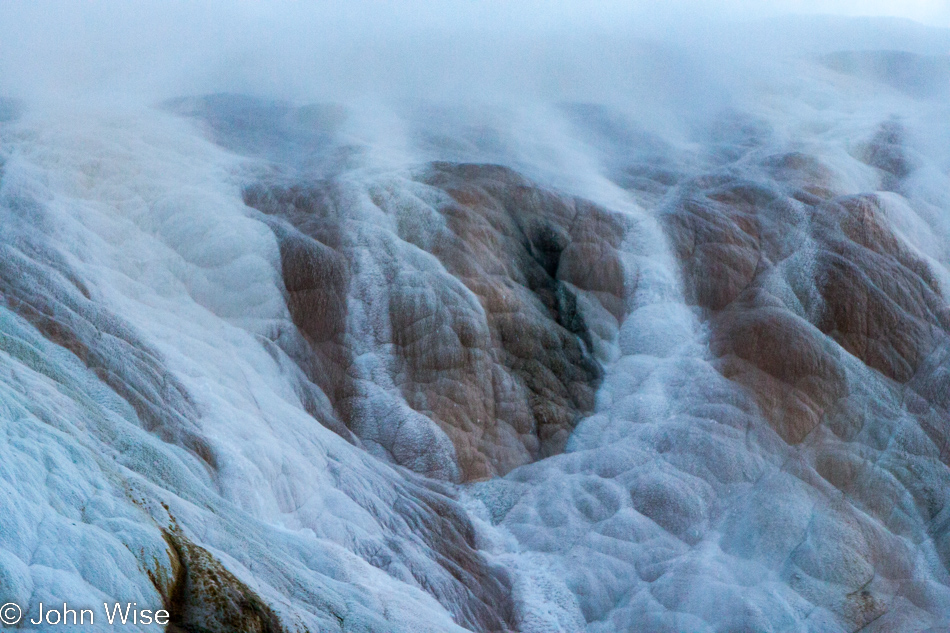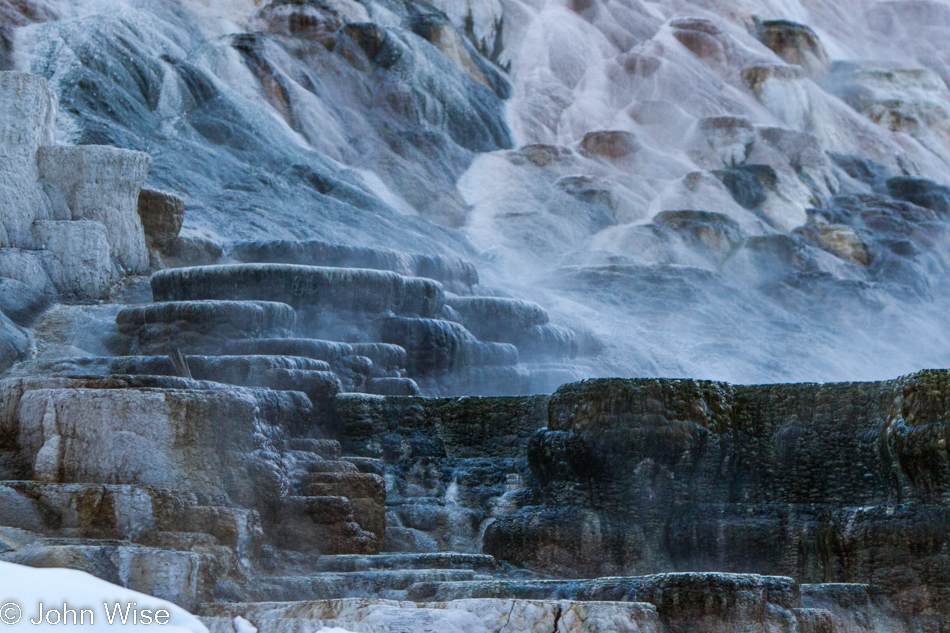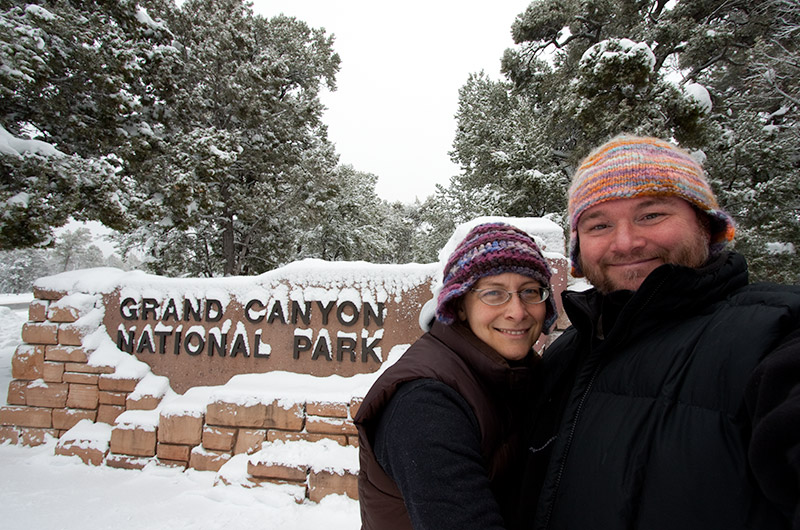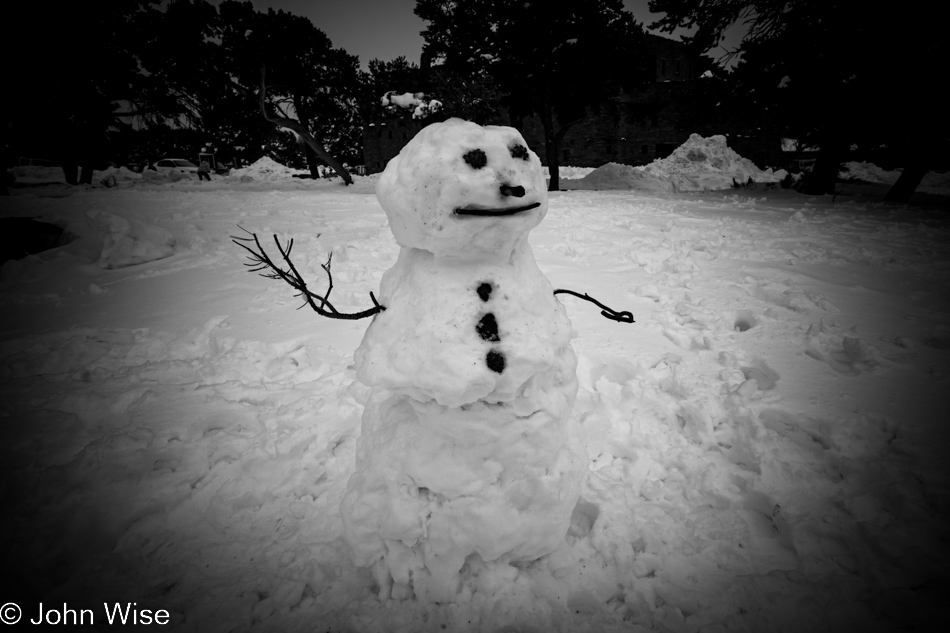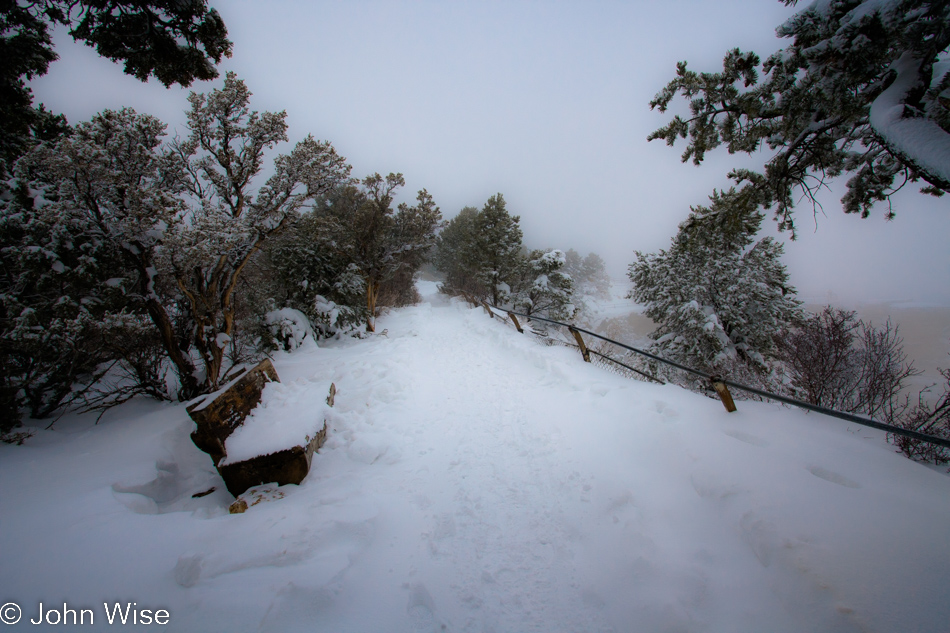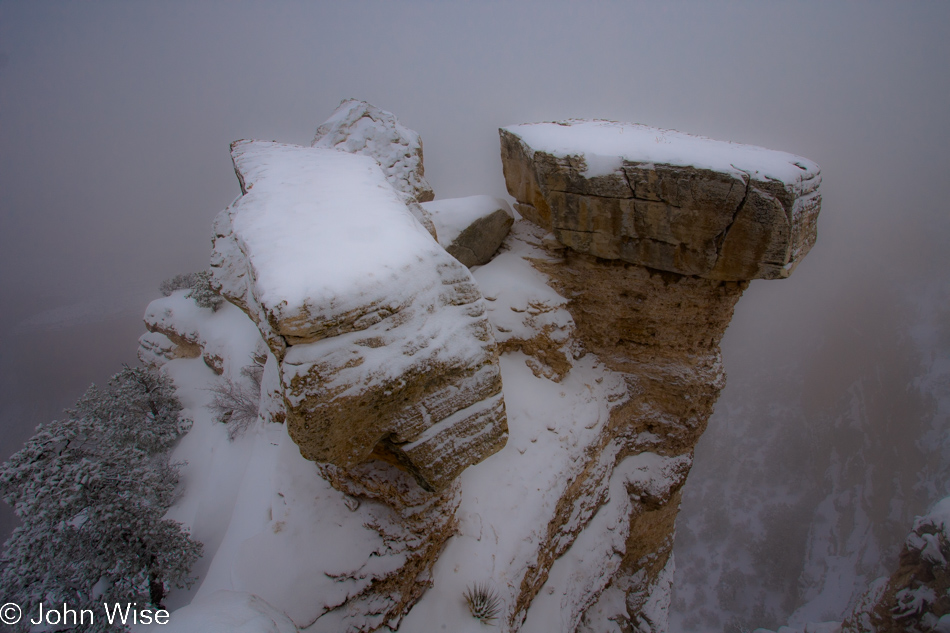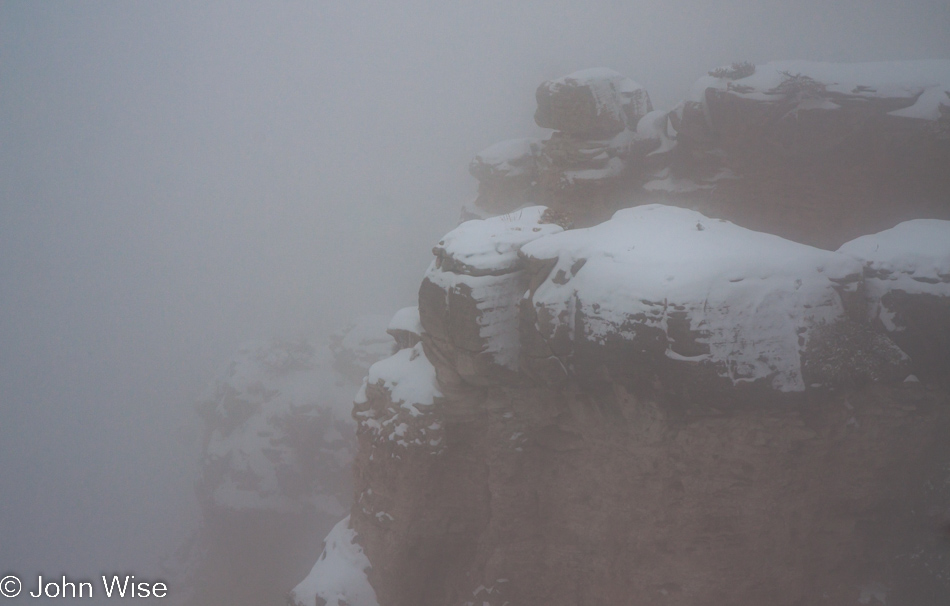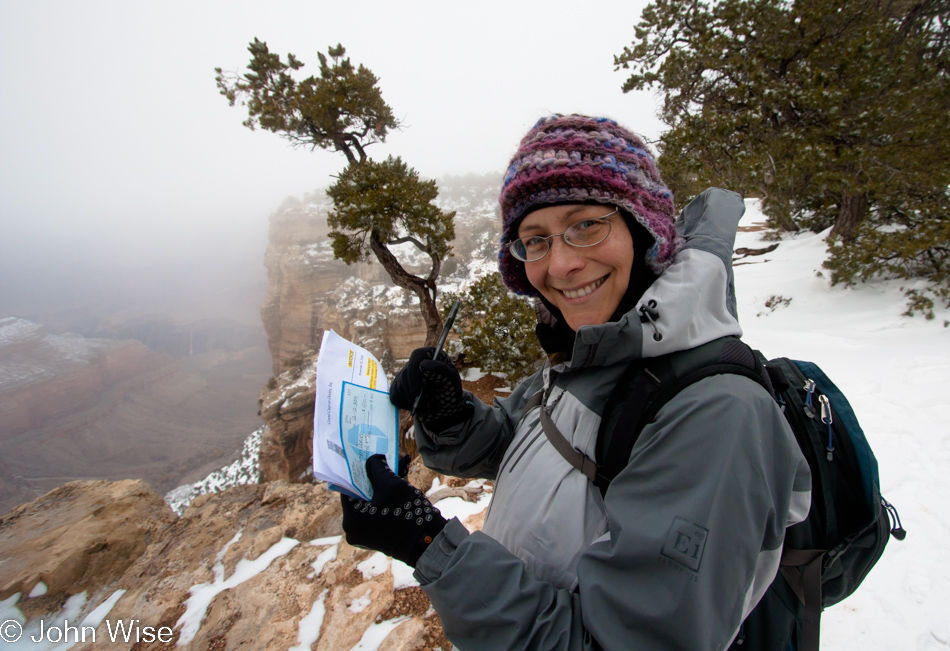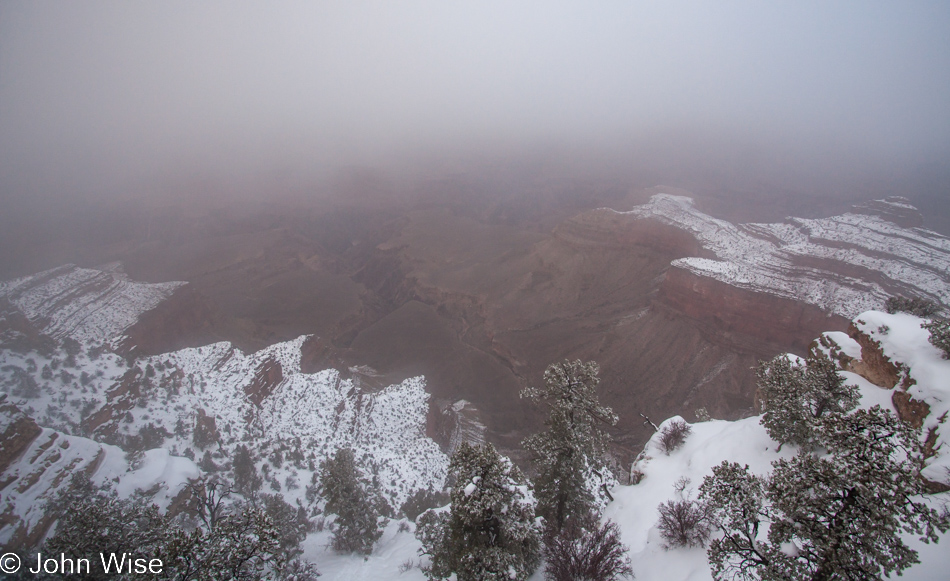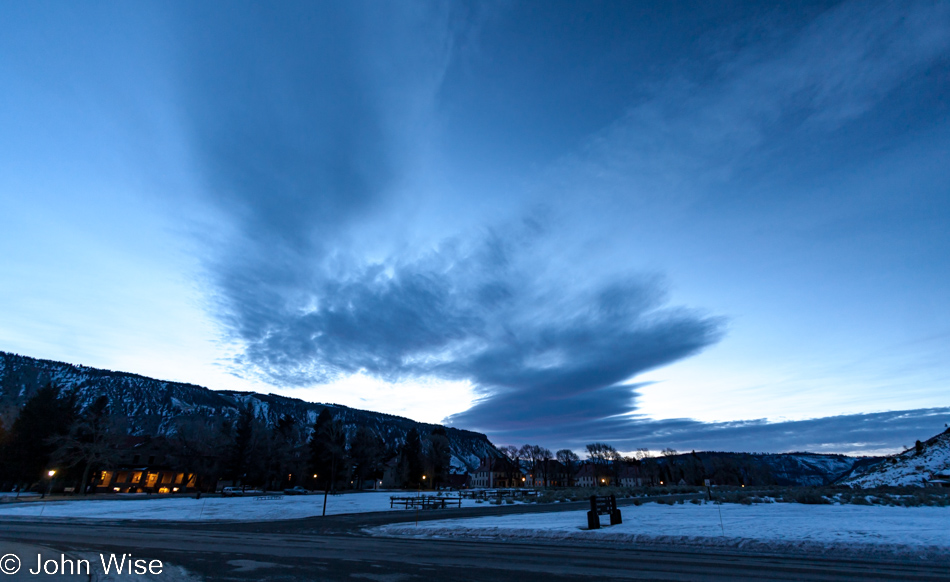
Good morning, blue sky! Today is a transportation day. We are transferring from Mammoth Hot Springs to the Old Faithful Snow Lodge on the Upper Geyser Basin for the second leg of our Yellowstone in winter adventure. Considering we’ll be traveling fifty-four miles south in a snow coach at speeds between 15 and 20 mph and won’t arrive at the Upper Geyser Basin until noon, I worry that the day will be short and mostly spent crawling down the road. I couldn’t have been more wrong. Following an early breakfast and shortly after sunrise we once again board a snow coach. And guess who our driver is? Tyrene, again, that’s who.
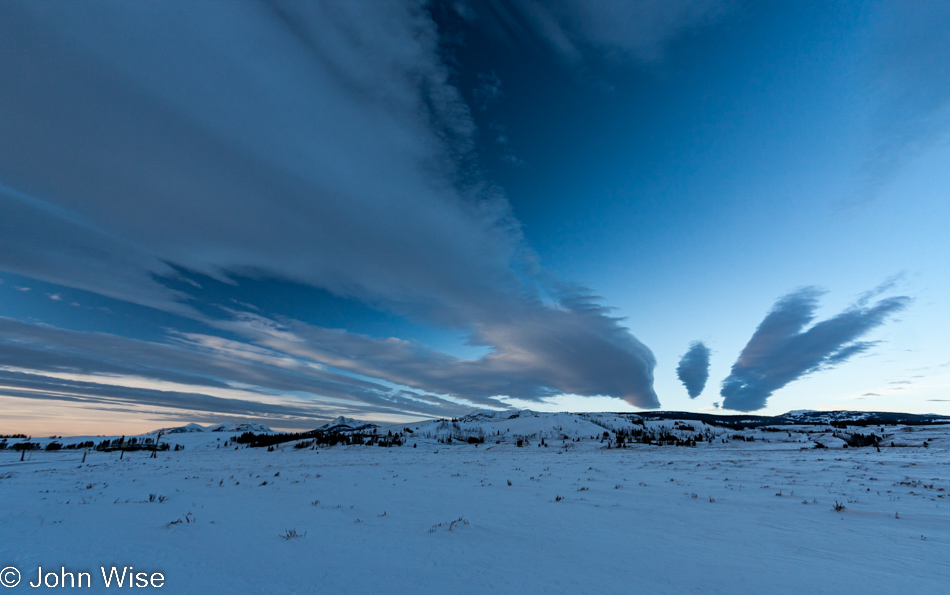
Sunrise to sunset this day would prove to be non-stop terrific. We travel south on the same Grand Loop road that took us through the Golden Gate to Norris Geyser Basin the day before, and again, we stop at Swan Lake Flat. The awakening day unfolds with a beauty intent on flattering these lands of Yellowstone.
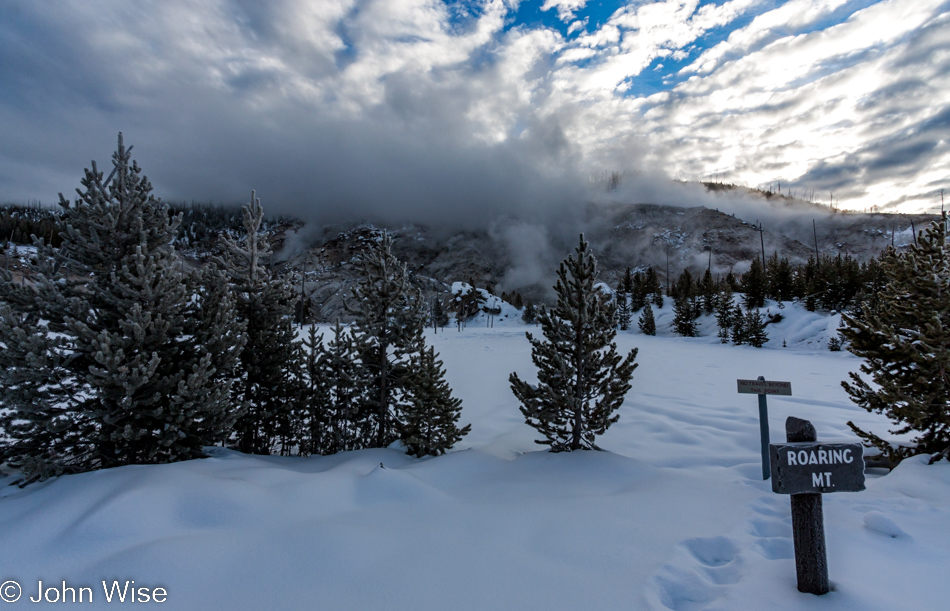
As the growl of Roaring Mountain comes into view and earshot, a thought is awakening in me and is reinforced by the serenity and seeming isolation of this winter expedition in the park: I am growing fond of the quiet and absence of crowds. I am enjoying the taste of the wilderness. And my thoughts keep talking to me, prodding me to consider that our next winter visit should include a private charter. It works like this: you pay for your guide and the vehicle time, either half-day or full-day, and you direct where you want to go and how long you want to linger, absorbing the surroundings free of obligations to others in the group tours and time constraints.
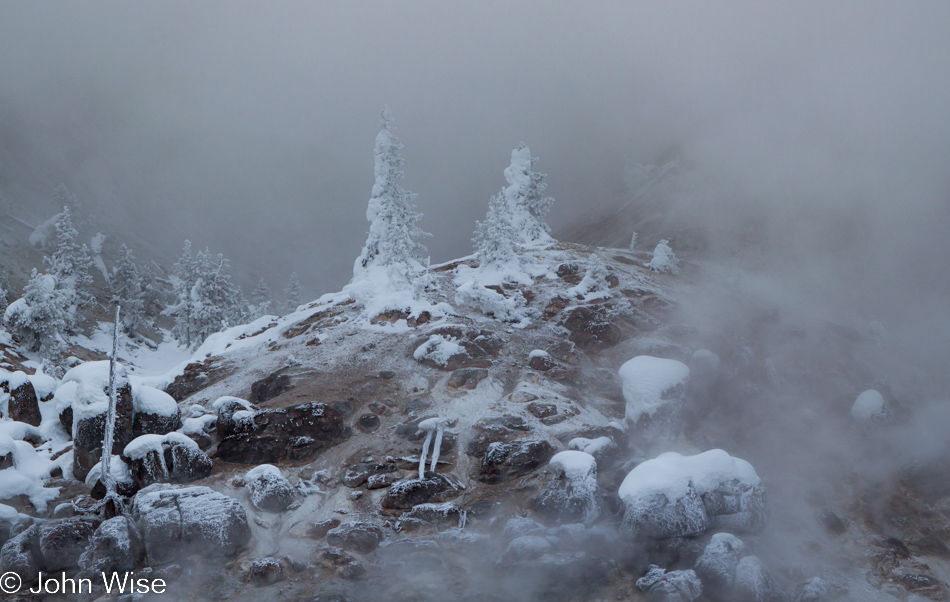
Steam and snow are a regular winter feature. I focus on these two snow-obscured trees as fog-like clouds of steam billowing from the depths of Roaring Mountain wrap and disguise the surrounding area. No cars are chasing by. The snow mutes other nearby sounds, allowing a focused precision of listening to the shrouded mountainside just in front of me. Through all of the geological processes and potential danger that lies below the surface of this giant volcano of Yellowstone, there is peace to be had on these winter days. Crowds and noise are a regular summer feature. By evening, I’ll find myself becoming disenchanted with the tourist face of Yellowstone and start dreaming of seeing the park that snowmobiles, cars, motorhomes, trucks, tour buses, and maybe worse, those who are always connected don’t venture into. A certain Ranger Program from the last night seems to have infected my thinking: Can wilderness really exist when people stand, where others had once communed with nature, blear into a cell phone at someone a thousand miles away about how wonderful everything is? I understand the sentiment of the gesture, but the need for instant gratification by publicly exorcising their senses destroys the remoteness. I have come here to have a break from that which I am familiar with, to leave behind the routine. Will the park, going forward, cater to those of us looking for nature or to those who desire to capture a moment that allows instant telephonic bragging rights? For now, I cherish this place, where TV is not found in hotel rooms, where for the time being, cell phones only work within a certain distance of the front desk, and no bored teenagers sit with backs turned to Grand Prismatic Geyser thumbing in a text message of how this all sucks.
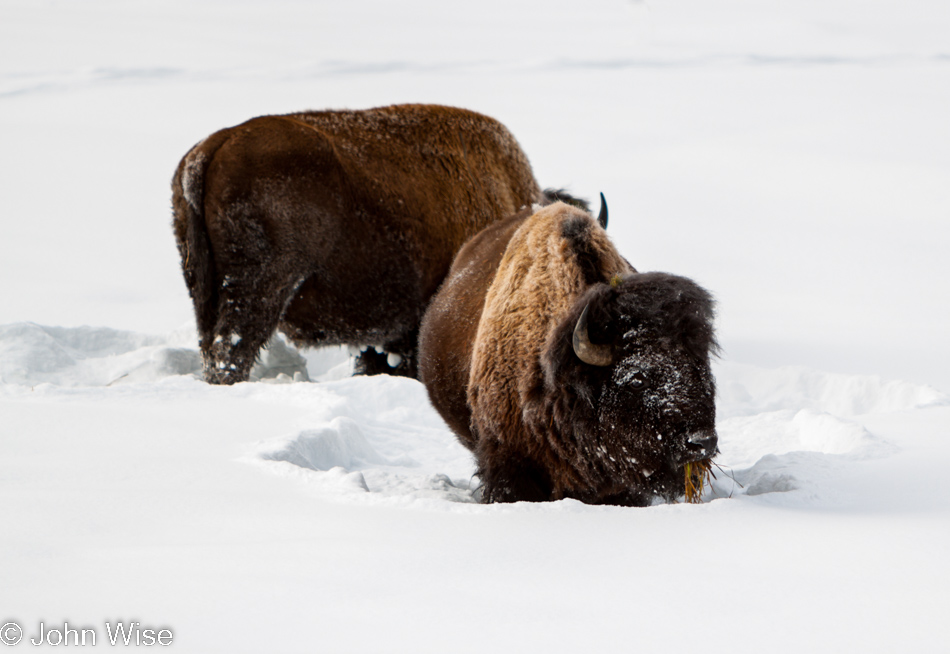
A mild winter is allowing these bison near-effortless grazing below a thinner layer of snow than in previous years. The cud of my mind is one of the great pacifiers as the world, for a moment, is still innocent. Life is functioning in accordance with nature. We are passive observers witnessing these elegant beasts do what instinct demands, and the collective “we” of those in the snow coach sit in awe – maybe this, too, is an instinct. Then again, there are the stories of those not content to relish this gift of a National Park, bequeathed as a privilege, a place reserved for just these opportunities, those who are willing to risk this inheritance and shun responsibility by placing their children upon the backs of bison, or, through their neglect, allow their children to fall into a hot spring. To me, trading places with a bison, to be standing in the snow chomping on some cold, out-of-season, brown dead grass would be a welcome exchange if I could only forget how much will change in Yellowstone as spring rolls around.
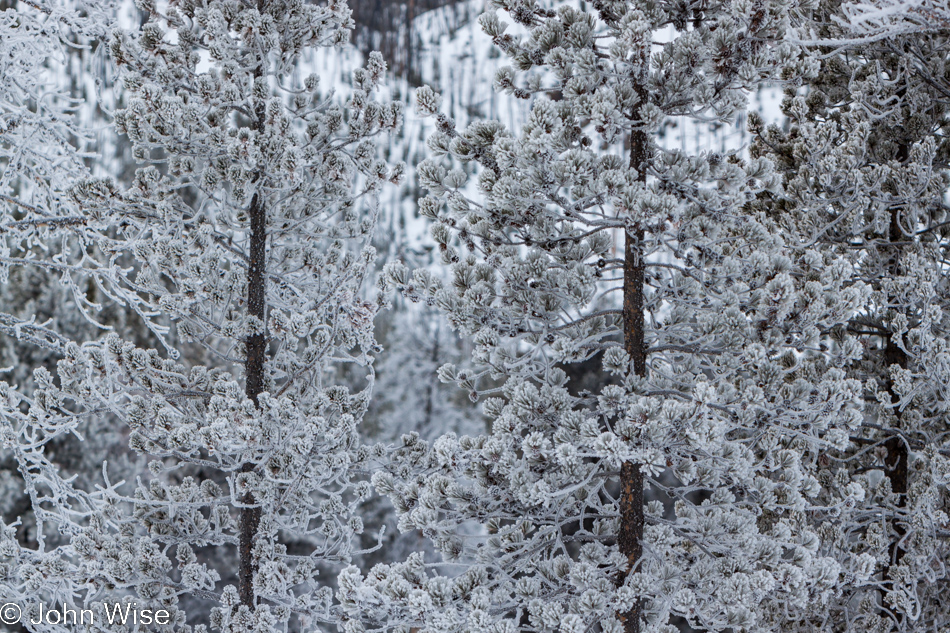
Serendipity at work again. Norris Geyser Basin is not to be seen this morning; it is wearing a heavy layer of fog hiding all of its seductive parts. But that doesn’t matter because it was yesterday under the sun and blue sky that chance allowed us to look in wonder at a postcard of delight no artist will capture, even with all of the paint in the universe or with a camera the size of the Hubble telescope. It was our eyes, those two little orbs connected to a three-pound blob of flesh, that allow 120 million rods and 7 million cones of the retina to translate received light into electrical impulses that stream over 1.2 million fibers of the optic nerve to be interpreted by the brain and stored in our memories, which we will carry and enjoy in the future, of a day at Norris that no one but us will have ever seen or will ever be able to see, it was all ours, and that is just amazing to me. These snow-covered trees above stand witness that someone in a snow coach has just passed with too much time on his hands to think some very strange thoughts.
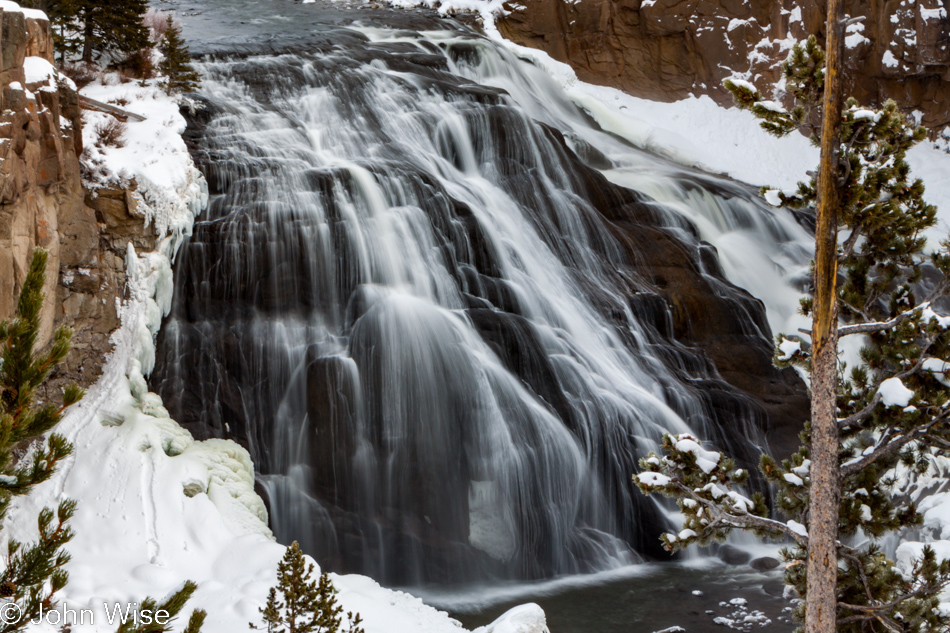
Seven minutes. That was how much time we had to get out of the snow coach and look, stare, and gawk at Gibbon Falls. How do I know it was precisely seven minutes? As I stepped from the van I was extending the legs of the tripod. Fifty feet from that van, I had my camera on the tripod and started snapping photos. I took twenty photos, some snapshots, and some long exposures such as this one. Heck, I just barely started enjoying myself before the voice in the not-too-far distance pleads with my sense of abandonment to let go and join the toasty tourists who are awaiting my return to the snow coach so one and all can continue down the road. Harumph.
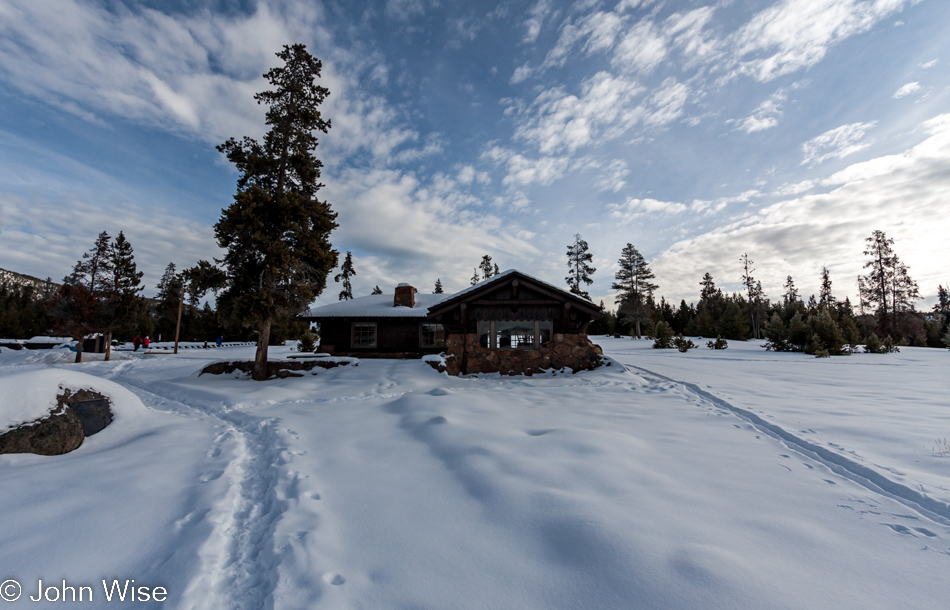
Madison Junction pit stop. Everybody else, head for the restrooms. John, run for the scenic area; the call of nature is easily delayed with Depends. Those fools are going to wait in line to relieve themselves and then again for a hot chocolate in the warming hut. Don’t they know the Madison River is just out of sight down the embankment? Don’t they want to look at the cute little log building that, in summer, is the Madison Junior Ranger Station? National Park Peak stands in the sun, the Madison River before it, and an untouched snowfield between me and all of this beauty. Is it really all just for me? Here comes Caroline, having forsaken the hot chocolate for her own little peek at this lovely scene.
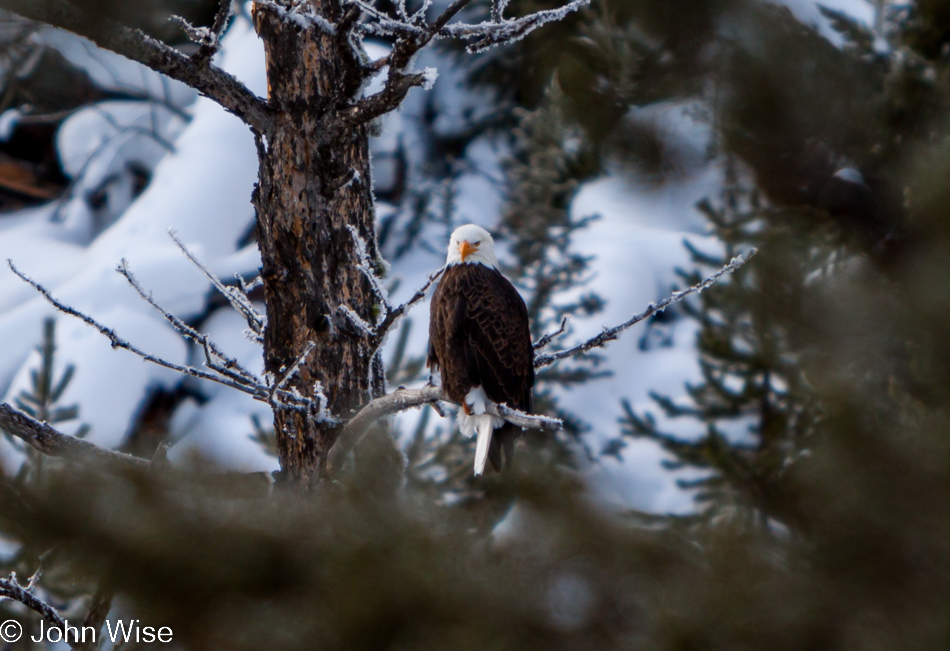
Oblivious to my newfound secret cache of beauty, the other passengers look content; better, they know not of the delights that have enriched me, leaving me wealthy with sights beyond what any man can easily buy. Sadly, I don’t have long to cherish my horde of images. Shortly after returning to the road, we turn right onto Firehole Canyon Drive. EAGLE. Where? Up there. Up WHERE? In the trees, over by the dead one back there on the right near the left, you know, on the other side of the river near the tree with the branch going right. I can’t find it. From the backseat: I got it. I still don’t. Me neither. It’s right up there, point point point. Can’t you see it? NO! Oh you mean there, ok, I see it. Grrrr, I still don’t. Tyrene pulls forward; ah, I see it now. But now I can’t see it from back here, comes a voice from the backseat.
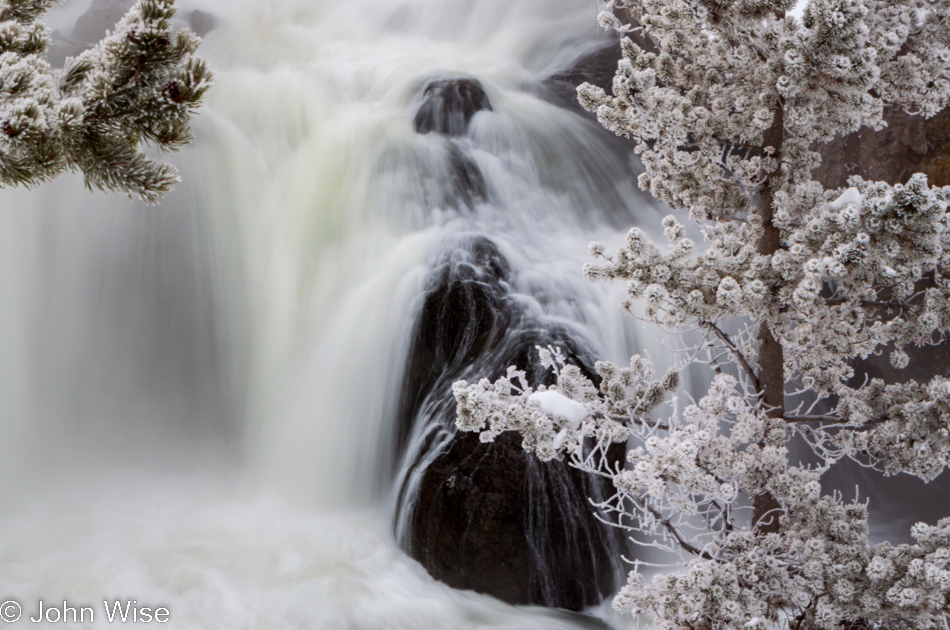
If there is a road here, it is here for a reason. Two reasons, really. One is the swimming hole, popular during the main tourist season, and two, the Firehole Cascades. Three, if you ask me, the entire canyon is stunning. Maybe four, if you ask me again, there are eagles here. Given a few more minutes, I could deliver a fifth, but I think you might start to see a pattern where this ordering of attraction might be limitless. Curses upon time limits, a quick dozen photos, and by now, you know the routine. All the begging in the world won’t give me an hour to walk the canyon and enjoy its wintery splendor, although I am again encouraged to reserve a private charter for our next visit so we may indulge ourselves just as I wish to do right this moment. This line of thought and suggestion is gaining traction.
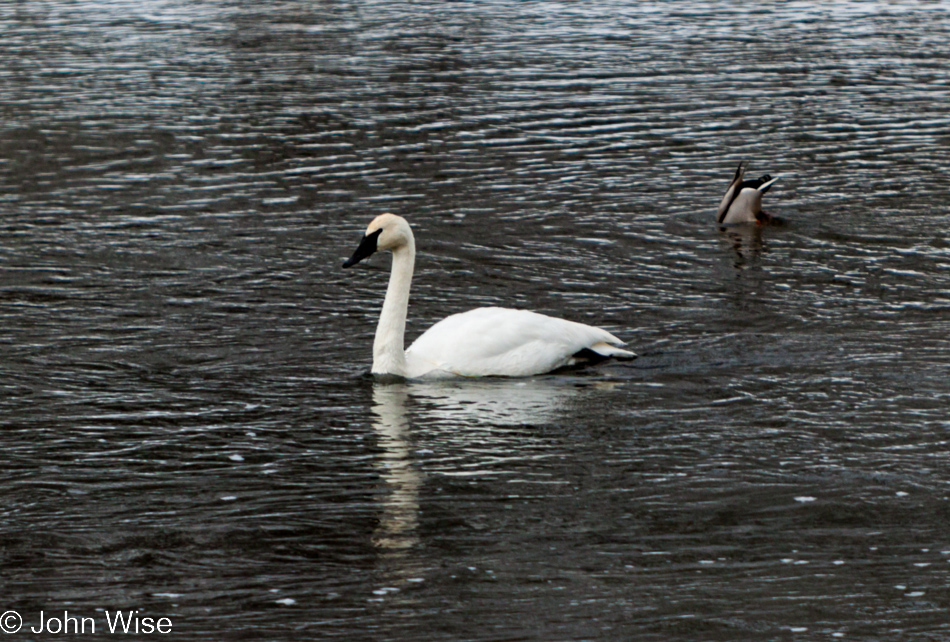
Before the waters reach the Firehole Cascade, they lumber next to the road, casually flowing along with nary a distraction. We, on the other hand, are in a near-constant state of distraction. Looking, scanning, and peaking through trees, we are hunting for what else can be seen. On the river, with all the attendant grace one would expect from the bird that symbolizes all the characteristics afforded royalty, is the ever-lithesome Trumpeter Swan. It floats without effort and bends its head in that swan-like way, eliciting the kind of praise deserving of this kind of deft water dance. As we applaud, some wipe a tear from their eye.
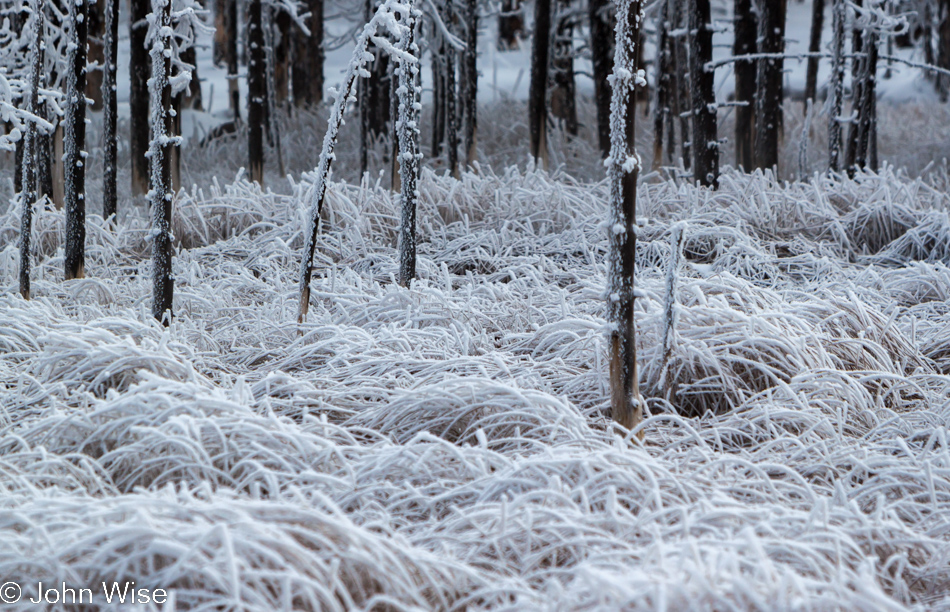
Bobbysock forest and fields of ice. I, the lucky one, am allowed one unscheduled stop before completing our southerly drive to Old Faithful. The bobby socks trees on the east side of the road are a favorite of mine. In the spring, the green grasses stretch upward as steam rises through the thicket between dead trees on one side and a line of still-living trees on the other. These lodgepole pines have absorbed too much of the heavily mineralized hydrothermal waters; drunken on the Stoney soup, their trunks begin to whiten, and the trees above wither. Where else can frozen death be so impressive?
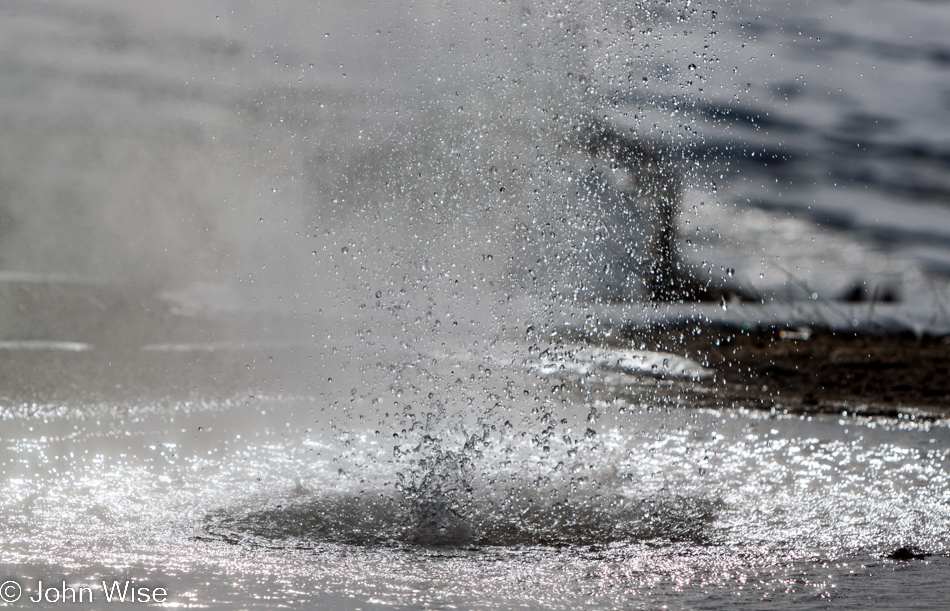
It is now just past twelve o’clock in Yellowstone National Park, and we have arrived at the Snow Lodge next to Old Faithful. We don’t need lunch; we don’t need to check into our room. I arrange to have our bags delivered to our cabin, and like a geyser, we erupt in our enthusiasm to throw on our Yaktrax and make like a bullet train to the Upper Geyser Basin boardwalk to spend the rest of the day. On the way over, we stopped at the Visitors Center, not for instructions, but for Caroline to pick up her Junior Ranger kit, a fanny pack containing a thermometer, a magnifying glass, pencils, and crayons. We circle around Old Faithful Geyser, leaving the crowds behind, and cross the bridge over the Firehole River to begin our four-hour tour.
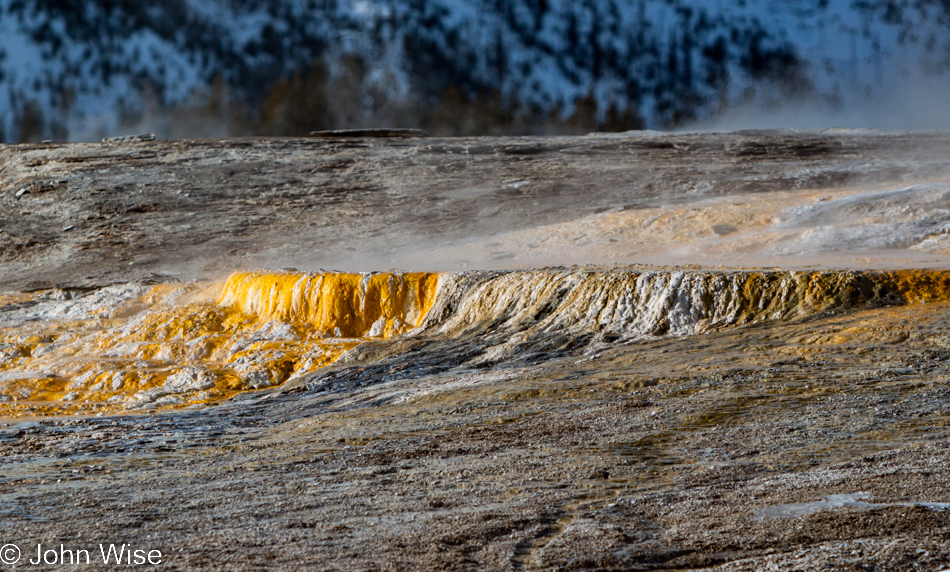
Frenetic eyes scan the horizon, re-cataloging and cross-checking the inventory of memories past that still wafts through our sense of place. Where and on what should we bestow our attention? How does one see everything at once that is stretching into infinity? Recognizing that most things seem to still be where we left them the year before, we look closer and dig more introspectively to find the subtle changes that have surely continued to alter this landscape. Maybe the orange on that travertine ledge is orangier. Was that developing terrace even here last year? Could it be possible that nothing is really the same? Is it a trick of the mind to wash away what it has known to allow us to fall into this all over again and feel the novelty that guided us on our previous visits?
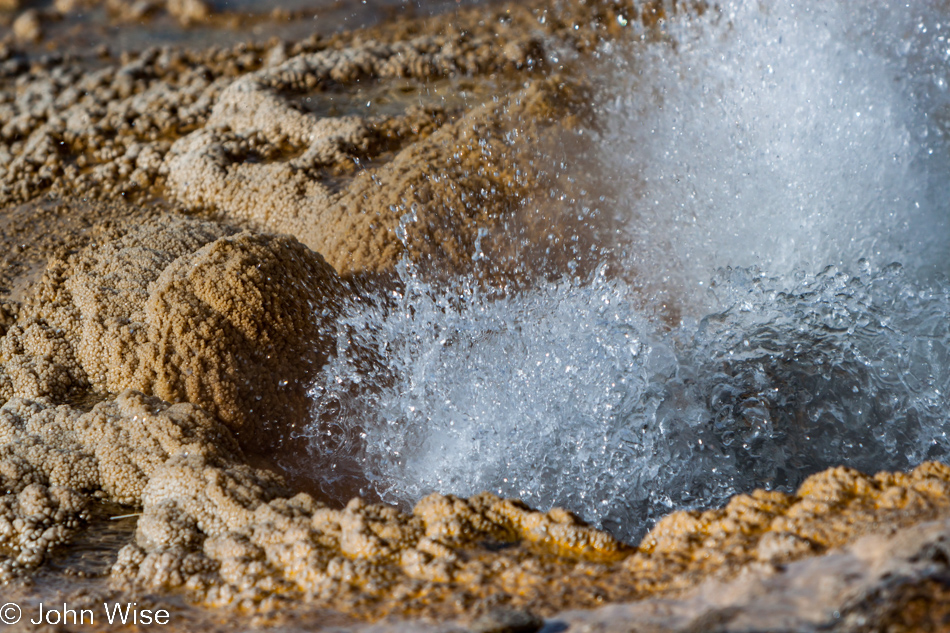
Maybe the air is different; it is warmer than last year. The sun, is it in the same place in the sky, is it casting shadows with traits not previously seen by us? Humidity could be playing a part and the density of steam combined with a wind blowing contrary to the direction our memory is showing us is creating the illusion that this particular geyser has qualities we are seeing for the very first time. Is this part of the magic that draws us to return, to check and be sure that what we think and feel we saw really is what we thought it was?
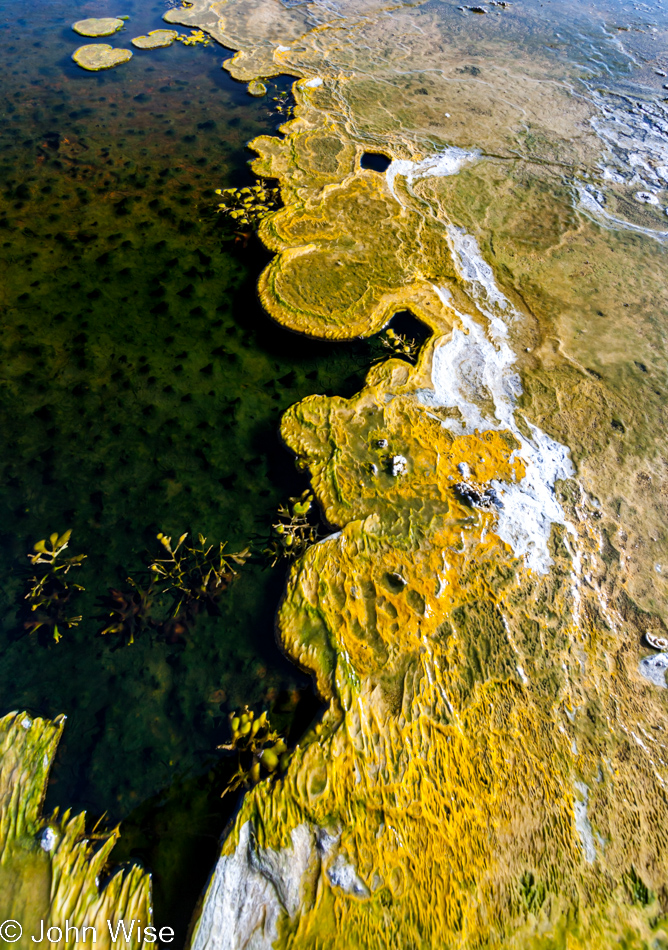
We pinch ourselves, not to wake ourselves from a sleeping dream, but to know and recognize ourselves living a fortunate, recurring dream state to be enjoyed and delighted in again and again. When Caroline and I look at one another, we lose valuable time enjoying the geyser basin: every time we are done with cheek-inflating grinning smiles, we must unclench the squinting eyes of overwhelming happiness that beg the question, are we really here? That moment of shared bliss is accompanied by some awkward, all too oft-spoken, well worn hackneyed exclamation of delight using a poverty of language that, due to the other stunned senses clogging our verbal abilities, is barely able to eke out a wow or a stammering grunt of, “Isn’t this amazing?”.
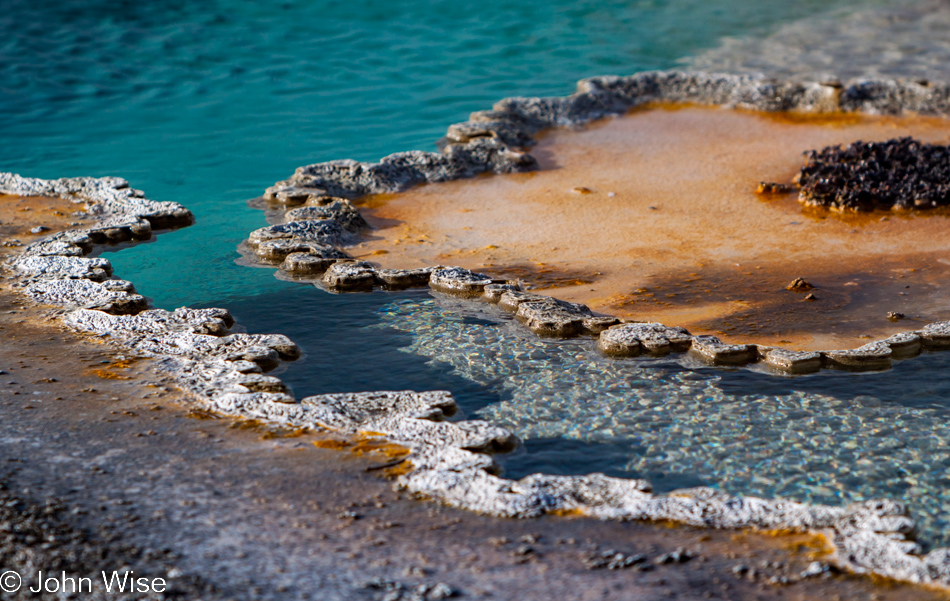
Thump, thump, thump, or so I think I am hearing. Is this my blood pressure reacting to the altitude, or am I hearing a nearly inaudible pulse? I stand still at the edge of Doublet Pool and train my ears to something that might be coming from this hot spring. I hear nothing. And then thump, thump, thump, and it continues. I’m still unsure if I am hearing something at all when, in the stillness and quiet surrounding me, I can feel its pulse. I am about to call Caroline over to have her senses verify that I am hearing and feeling what I think I am when, on the next thump I think I can see a concentric ripple spreading from the middle of the spring outward. There seems to be a connection. I try to stare and feel with all the might of concentration I can muster, and through the water, the next thump appears to lift the center geyserite mass; a ripple begins, and my feet, eyes, and ears want to confirm that this is precisely what is going on. Time to call Caroline just as the thumps fade, and I am left now wondering if any of this observation is real or manifested in a desire to see something extraordinary. She can’t hear it, feel it, or see it. I ask her to wait, and in a second, thump, she can’t hear it but thinks she felt it. Thump, she’s almost certain she felt it, too. Thump, “Oh, you mean that!”. Now she hears it, now she feels it, and finally, the senses synchronize the events into a phenomenon she can be in “wow” of too.
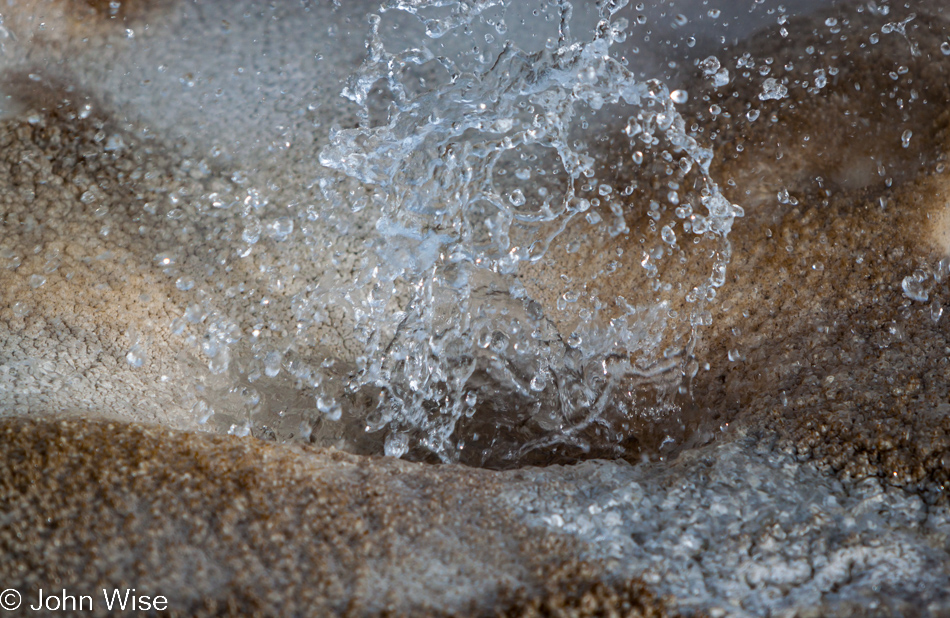
Spasmodic, just by its name alone, you are coerced to want to appreciate this geyser. Spasms jolt water from the earth below and from various exits on the surface; they convulse upward and outward. Spasmodic Geyser is at work. Agitated, it snarls hot water and steam, taking turns from which hole they will vent. A kind of “Whack-a-mole” game of spurting heads, asking for a giant rubber mallet to pummel them back into the passage they have attempted to escape. We are not allowed to oblige.
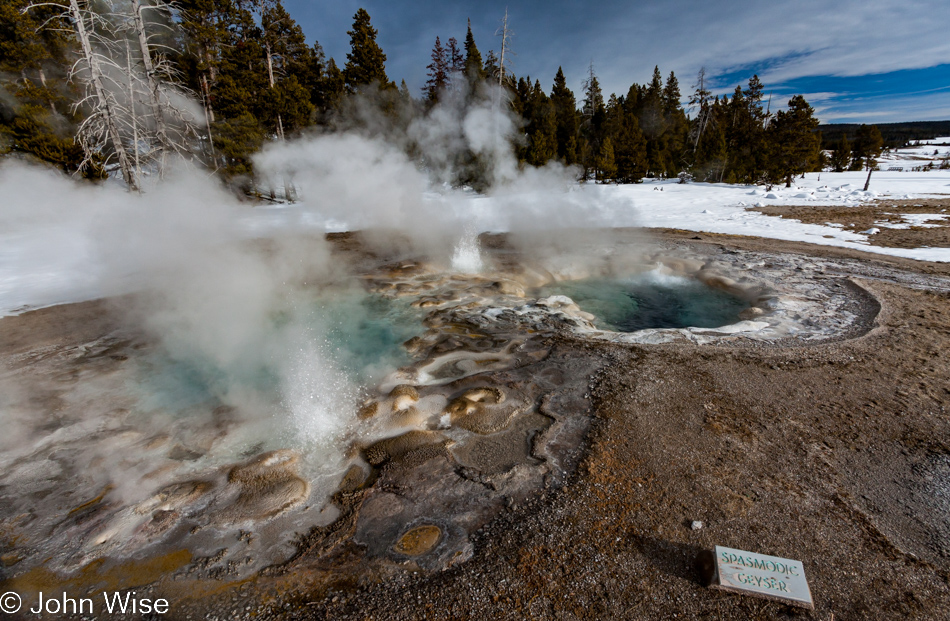
Now, step back and see the glory of Spasmodic Geyser in its entirety. Tan, brown, white, and gray surfaces punctuated by aquamarine waters bubbling forth, the steam swaying in beguiling enchantment hiding the danger of what this really is. Nearly uniform, small, flat, smooth stones the size of silver dollars have collected in a pool that defies our ability to understand how they came to rest here, not conforming to any of the natural artifacts found in any other hot spring. Where water flows, the geyserite below is bleached white. Further away from the eruptive centers, the water cools, and the earth shows darker shades of a theme. When one vent quiets, another takes over the gurgling wretch of spewing trapped waters for our purview. Like an Orchestrion of another age, a hidden roll actuates the various instruments that bring life to Spasmodic Geyser, each opening finding its voice to offer a syncopated visual and audible rhythm played by mother nature for us to dance a spasmodic celebration too.
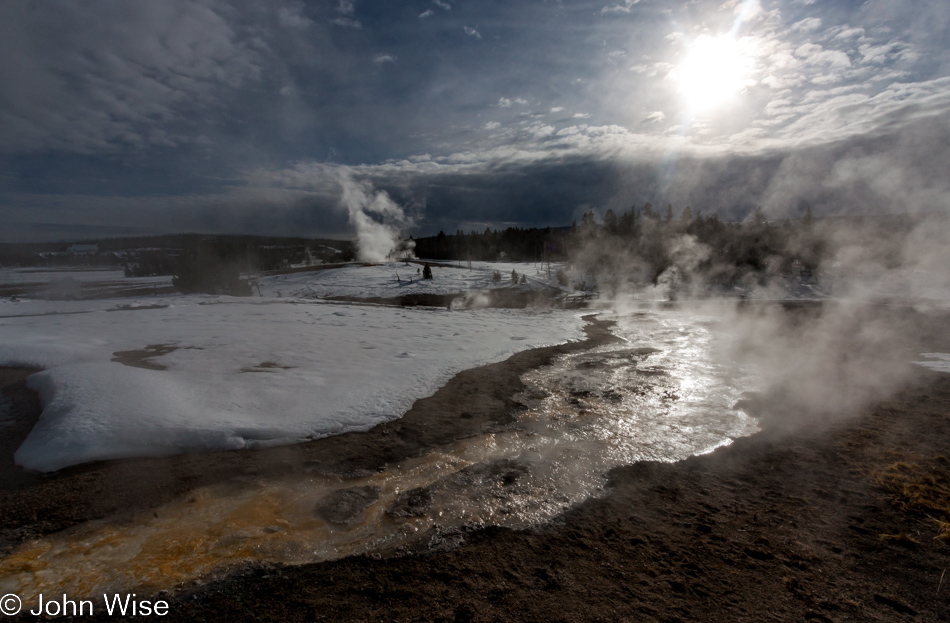
It’s only 2:30, and the sun looks low in the sky. The idea that we are so absorbed in our environment that more than an hour and a half has passed out here and we have barely walked thirty-six hundred feet astounds us – our pace is nary a bit faster than a snail’s. Sure, that’s an exaggeration; the truth is that we are closer in speed to Tegenaria Atrica (a common European house spider capable of top speeds of 1.1 mph).
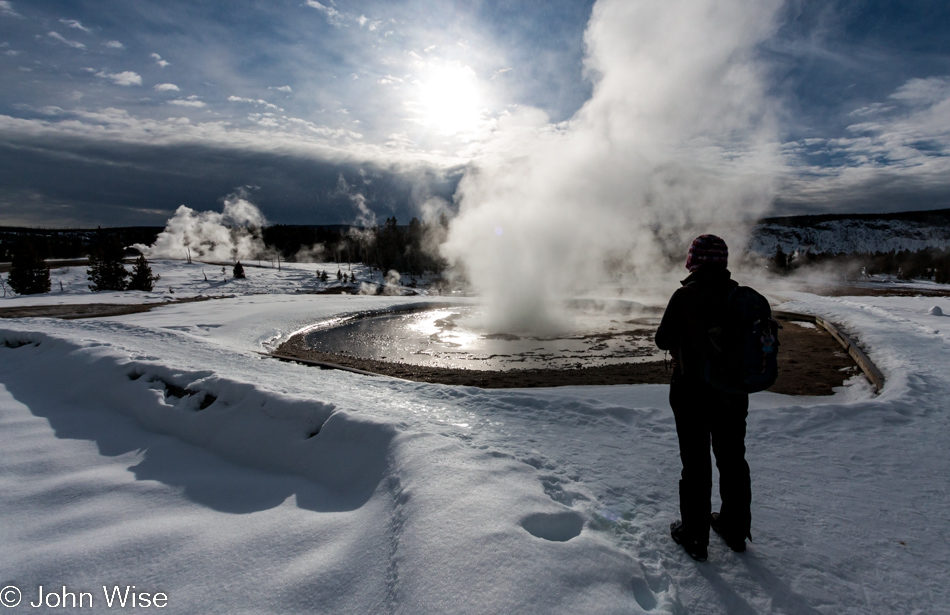
Every reflection, every shadow, the glistening sun on the water, all of these distractions are easily absorbing our feeble attention spans.
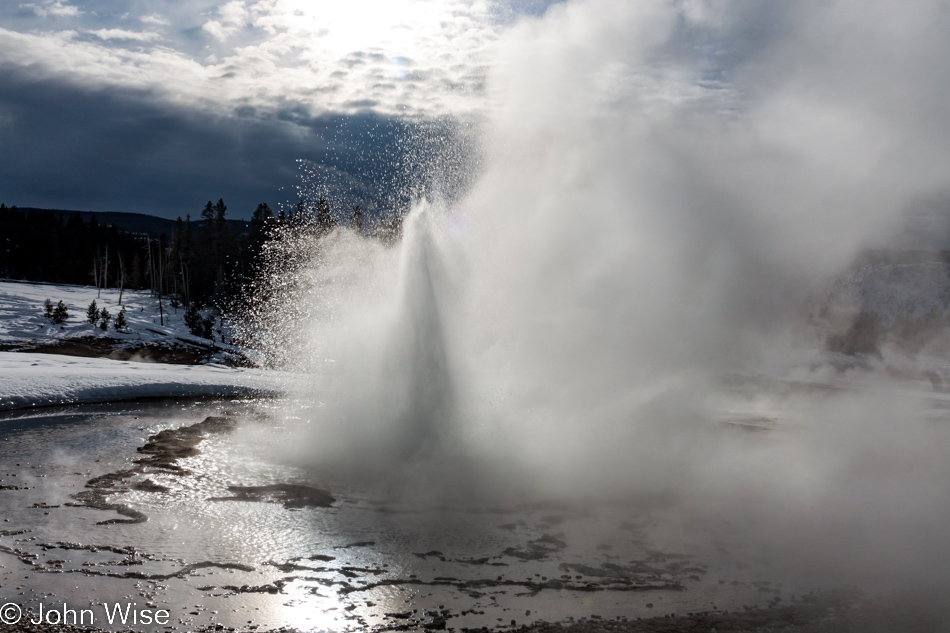
The Sawmill is buzzing. Ripping and shredding geyser eruptions are tearing at the sky. When the Sawmill is working, it never fails to deliver a job well done. The frequency of this geyser appears timed to our arrivals, although the guidebooks will tell you that eruptions occur every one to three hours and last for between fifteen and ninety minutes. Do you know how many photos can be shot in ninety minutes of spectacular geyser eruptions? Let me tell you, so many that you will find it near impossible to pick just three or even thirty that best represent the sight you were drawn into. I stood here only eight minutes, although I would swear in a deposition that I must have been geyser side for no less than the entirety of my 46th year, and in those eight short minutes I snapped off ninety-seven photos.
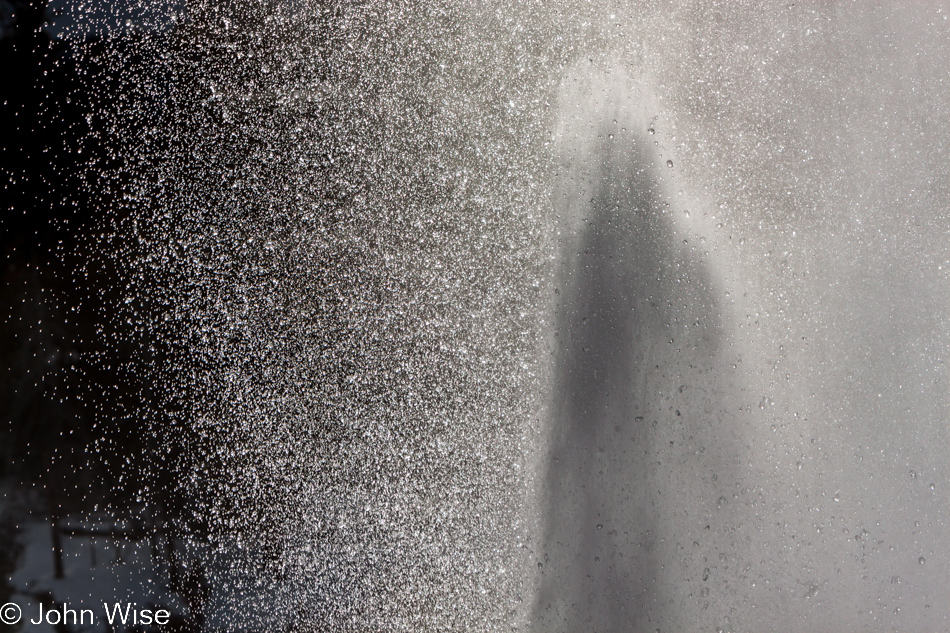
From out of the center of the Sawmill Geyser, the water rises through a thirteen-foot underground vent to be sent aloft, reaching heights approaching 40 feet. On this cold 25-degree day, the 189 to 207-degree water is disgorging steam while evaporating on its trajectory up. Atomized droplets surround and fall away from the center fountain, momentarily filling the air with a billion brilliant gems of varying sizes. Sunlight squeezes light through the droplets to sparkle like a night sky mere feet before you. The watery stardust washes over with a light wind that wraps warm steam around us, engulfing us with the snugly moist air and a thousand kisses from the misty bath.
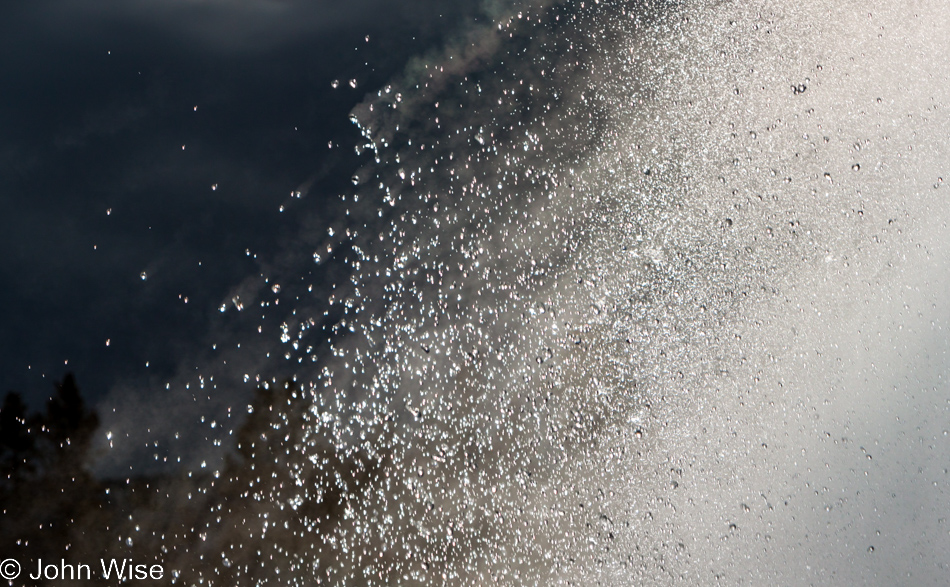
The hissing fits of explosive energy for which Sawmill Geyser was named have greater staying power than we do. It is only constrained by mysterious forces below, being operated by unknown plumbing while we are limited by available light and curiosity for what lies up the boardwalk. We try to pull away, but one more awe-inspiring eruption suggests that one greater than the previous could be just at hand. Like watching lightning during a thunderstorm, we wait for the next big flash. Each eruption has a unique signature shape. This time, the water may shoot out on a seventy-degree angle and the next straight up. Two and occasionally three distinct fountains, each heading in opposing directions, shoot at crazy angles, falling back to the geyser crater. The eruption is primarily hot water and steam, but most often, it is accompanied by the droplets escaping the main flow with steam runners following in hot pursuit. The fireworks of Sawmill Geyser never fail to satiate our feasting eyes.
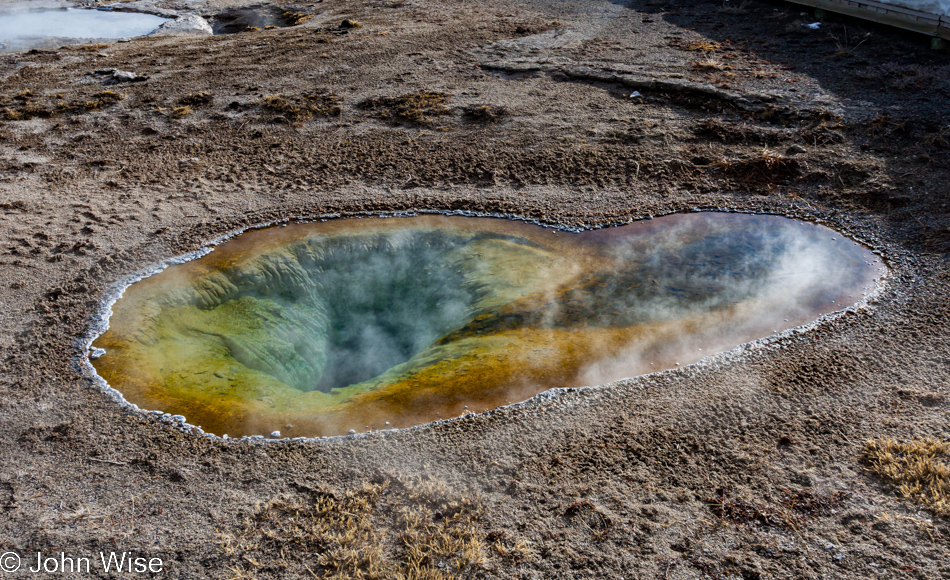
The pool of tragedy – Belgian Pool. Some years ago, a man from Belgium made a fatal mistake, somehow finding himself in this pool. The National Park Service repeatedly stresses how dangerous these thermal features are, but all too frequently, visitors choose either to ignore them or, through incredibly ignorant naivete, find themselves becoming catastrophically engaged in a scalding, watery grave. The equation is simple: the average water in a hot spring is 199 degrees Fahrenheit – even in the non-threatening-looking, cozy jacuzzi-like pools. At this temperature, you have less than 1/10th of a second to compose your now panicking self, sinking into the depths of the hot spring before finding a buoyant equilibrium as you flail and struggle to find a grip on something that can help eject you from this doom, covered in third-degree burns. But that is simply a description, just what does that mean? The scalding hot water has burned and destroyed all layers of your skin. There are no skin cells left to reproduce themselves – you are going to require skin grafts after your now-dead skin has been peeled off. Happy swimming, sad unfortunate nincompoops. Nature is not Disneyland.
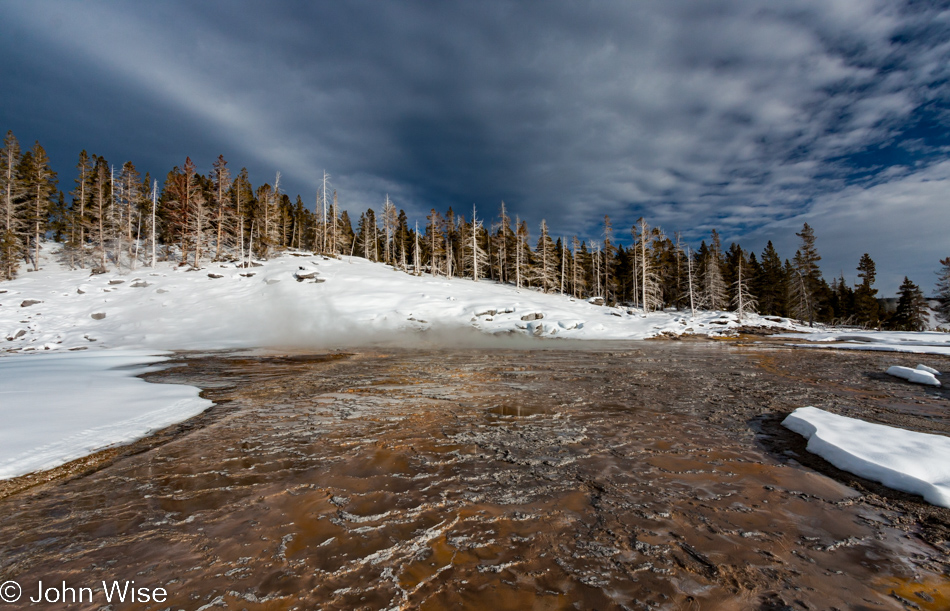
If the Sawmill is timed for our arrival, Grand Geyser is timed to sit timidly, quiet, and aloof as we make our appearance. Not that we haven’t tried to witness an eruption. On a previous visit, we listened excitedly to a self-proclaimed geyser guru who tried to explain how many Turban pool fillings (Turban is the feature next to Grand Geyser) had to happen before an eruption was imminent. After his statistics failed to deliver the much-anticipated glory of Grand, a few others who’d been waiting too decided to abandon hope. We didn’t, keeping faith with this young man’s enthusiasm – until he started to change the story. Maybe it’s five Turbans and two overflowing pools. Hmmm, just what kind of insight is he truly in possession of? A half-hour passes, forty-five minutes go by; it is time for us to take a pass and leave this geyser gazer to be the sole witness to Grand Geyser if and when it ever does actually erupt.
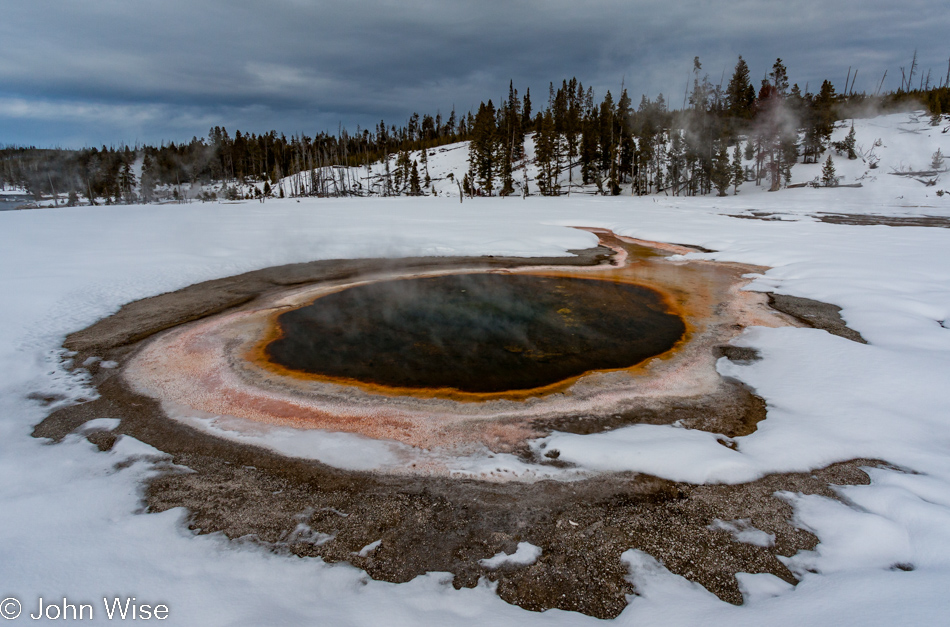
Here’s a thermal feature that will rarely look the same way twice: Chromatic Spring. Search for Chromatic Spring on Flickr or Google Images, and you will find a vibrantly colorful hot spring. On a cold winter day, only a hint of summer glory is visible in the pale orange and browning red ring that surrounds the main crater. The colder dark brown crater of this visit may not be as inspiring as seeing the summer-lit pool center reflecting the blue sky from above as it graduates to shades of green in the depths before transitioning to mottled yellows and oranges in the shallows with a darker ring of red with only the distant cooler edges the murkier brown we are seeing today. But we know and remember the sight seen years ago and will, with luck, be so fortunate to see it again.
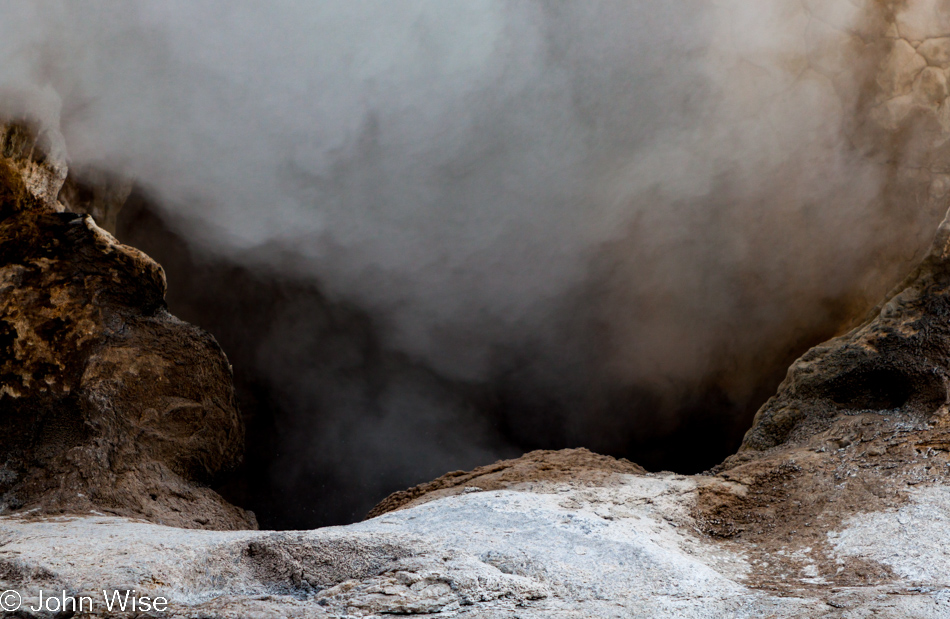
I have looked into the mouth of the Giant and lived to tell the story. At around 10:00 pm last night, this infrequent geyser roared, answering the age-old question about the tree in the forest. For while no one was there to witness the eruption, signs of its tumult were readily visible. Like a Satyr drunk on the consumption of nature, I disregard logic, enchanted by my newly found sylvan inner being imagining the powers of the deity to command the earth and geyser to perform once more its ribald hydrologic cycle, exposing all that it can show to us mortals who have gained entrance to its rare display. I look on in anticipation that mounts as the sputtering cone gives rise to a clamor of noise, suggesting my wishes are to be granted. Yet I am still looking on, waiting.
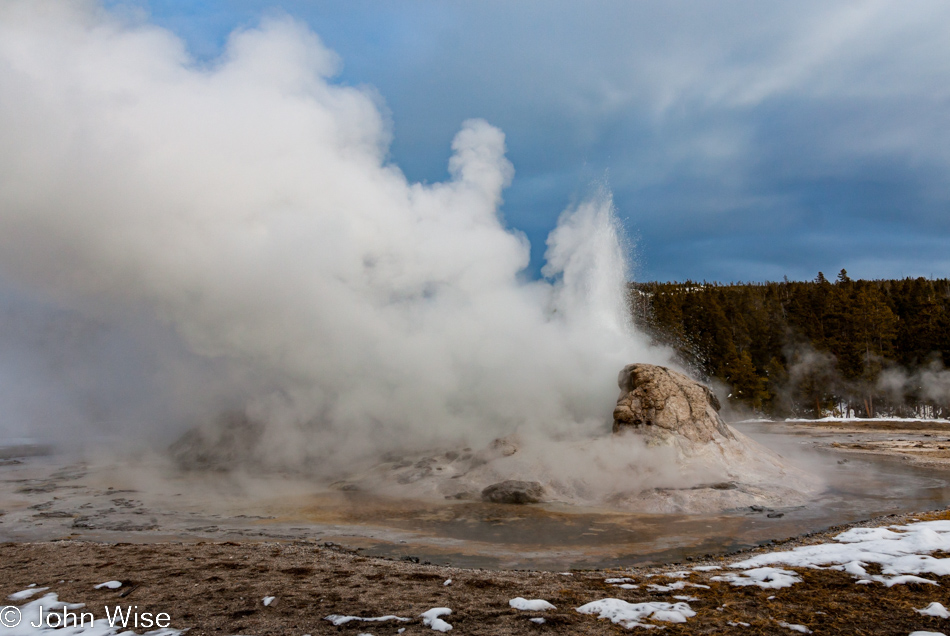
Escaping the Dionysian to enter the Romanesque, we have alit to Grotto Geyser. A spouting, splashing, mantic fountain from which Divinity appears to emanate, for how else could one explain the power of attraction this Grotto holds over my spirit? There are more statuesque thrones to the authority of geysers, where the cataclysmic fury of geology manifesting rage upon gas and water has built monuments towering leagues above the Grotto, even pitiful worn and over-observed Old Faithful stands as a bulwark in the imaginations of mere tourists, but it is this humble Grotto that has most often held sway over my curious mind trying to understand how the magic below the surface has channeled a path to my rapt attention.
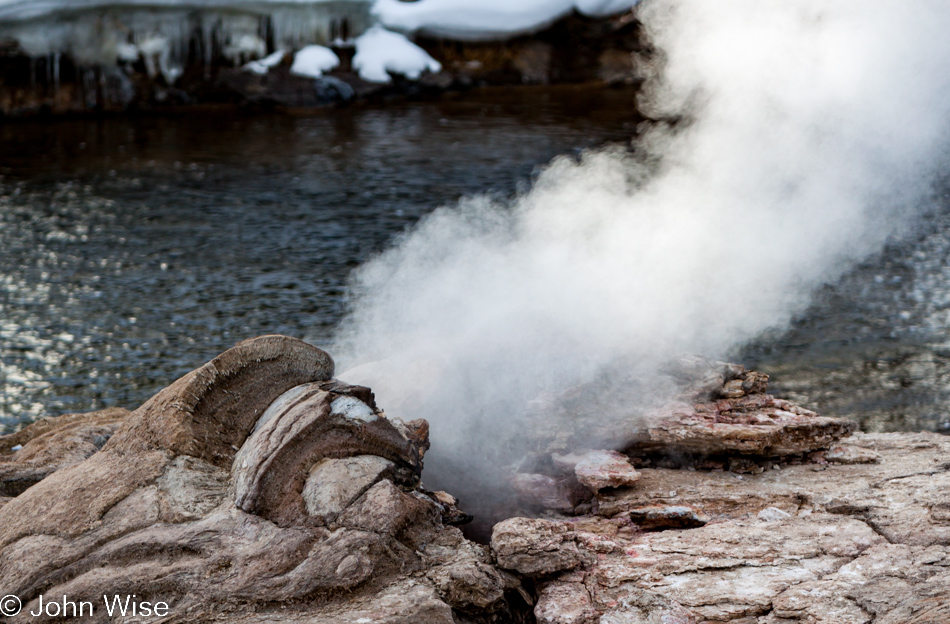
Reaching such lofty heights does not imply the lesser, not quite as magnificent; temples should demand any less worship. By this time and the exposure to the grandeur that saturates the senses and cleans away the cynicism, my eyes have cleared, and the heart has been set to purity so that I might accept what others witness as mundane. I see the extension of beauty whose long fingers play to massage the less fortunate ends of the sight horizon into radiating dramatic soliloquies of unspoken transient glories where clouded vision must be blinded to allow the mind’s eye to truly see what others have failed to comprehend. I am in love with this world of Yellowstone.
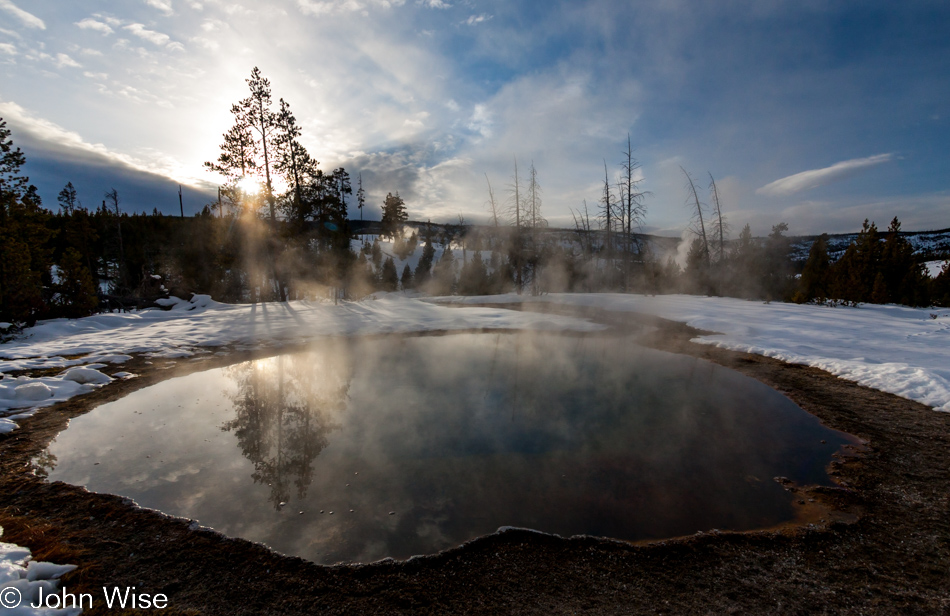
In a last fit of glorious rapture, the sun claws through the shroud of gray, spreading life-giving radiance upon the earth whose abundance it depends on. With all of its virtue intact, this pool known as Morning Glory is as glorious in this late afternoon as it would be found on any given morning. Rising steam embraces sun rays, guiding them gently to be reflected in the still waters below. This is our end of the road, near the end of the day. We raise a toast of tea to celebrate this January 16th, which began without much expectation, but at this moment is culminating with a display of warmth, giving us the satisfaction that we have seen all that was to be seen.
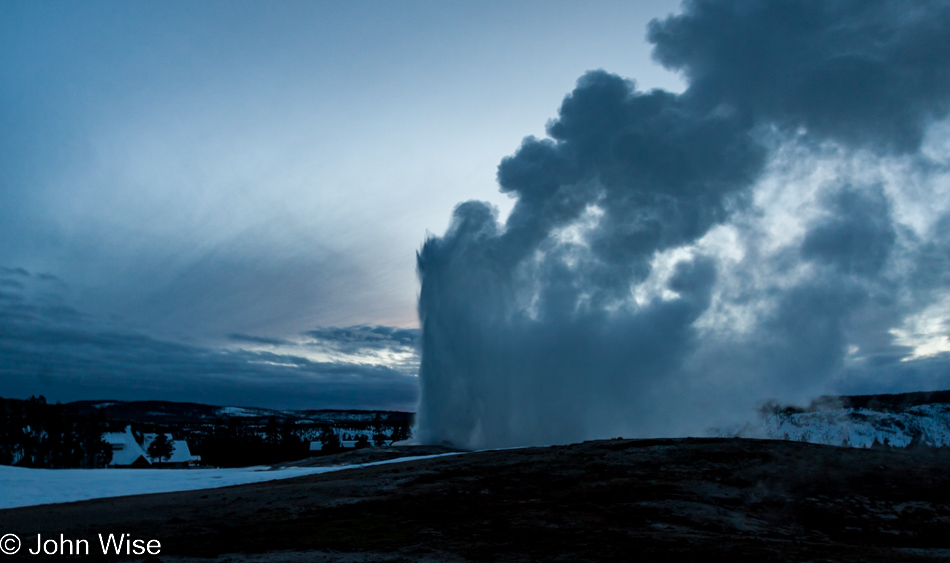
Intense, fragile, and precious are the words that best describe this winter environment. The sun takes its final bow; the air gathers together all of the cold it can find, squeezing away any residual heat that was present seconds before. Like a rutting elk lurking behind us, quickening our steps, the threat of cold finding a fissure through the layers of clothes prods us along to find shelter. Thinking I have seen it all, the presumptuous arrogance of a simpleton content with his full belly proves to be his folly. It looks like Old Faithful is erupting – it is.
